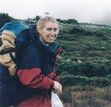Kerry Tolson's Blog, page 5
January 7, 2016
Flying monks and naughty clowns - the swirl of the Jampalhakhang Drub
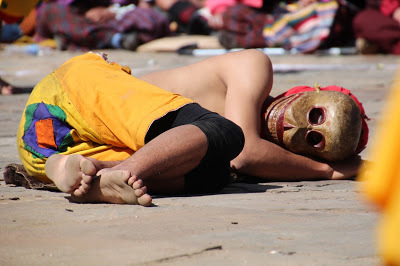
We're up early for day two of the oldest festival in Bhutan, the Jampalhakhang Drub - the consecration of Jampa Temple. The night before we'd attended the Mewang (Fire Offering) and Naked Man dance and became mesmerised by the trance-like dancing, while our necks crinked trying to find a vantage point to see the dancers and our butts froze on the ice-cold flagstone pavement of the temple courtyard when we did eventually find a front row squat spot. I'm determine to get a front row seat first thing in the morning for day two and encourage our guide to collect us from our hotel at seven-thirty am....even though the day's swirls, twirls and trance dances are due to start at nine.
We arrive early, along with a lot of other tourists, and peg out our perfect vantage spot. As the courtyard fills up I find myself feeling a little disappointed - most of the spectators are tourists - western tourists - there's barely a Bhutanese person among us. We all sit there with our tri-pods, fancy SLR cameras and for many, whopping great lenses. Lens envy starts to creep up on me when I see some of these expensive fancy-pants toys. The chanting soon starts and the festival comes to life and all thoughts of Ooh-la-la techno are soon gone as I am transported into an ancient time.
The second day of the festival is called the Tsukton (beginning) and is the 'proper' start of the festival - the dance circle has been purified by the Black Hat Dance and so now the mask dances can be preformed.

These dances have wonderful sounding names like Yamantaka Yab-Yum Dance and the Three Wrathful Dance. The Yamantaka Yab-Yum which is also called the Shinje Yab-Yum Cham, is performed first to expel evil spirits lurking about in the area. The bull-like mask is bright red with sharp horns which represent compassion. We're told that if the dance is viewed with faith and devotion, then we will receive powerful blessings. I would love to say that I viewed the dance with intense devotion, but the cheeky clowns wandering around the dance circle kept taking our attention and had us in fits of giggles...as well as trying to catch them in photos.

Dressed in a lairy version of what looks like mens hospital PJ's, the puce-faced masked clowns (Atsaras) wave with gay abandonment oversize bright red phalluses, teasing and gesticulating at everyone and their cameras. The lewd gestures become more and more cheeky as the clowns sing ribald songs with very eyebrow raising racy motions. Part way through the day, one of the clowns discovers we are filming the spectacular and decides to give his own dance - 'bonking' our camera.
 The chief Atsara however is more than just a clown, he is also the manager of the festival from beginning to end, making sure the dancers motions are in sequence or, if the performer makes a mistake - helps them get back on track. If a dancers mask falls off or there's a problem with the fabulous costumes then the Atsara is there to immediately assist.
The chief Atsara however is more than just a clown, he is also the manager of the festival from beginning to end, making sure the dancers motions are in sequence or, if the performer makes a mistake - helps them get back on track. If a dancers mask falls off or there's a problem with the fabulous costumes then the Atsara is there to immediately assist.The Stag Dance (Shazam Cham) is performed next, nimble and strong, taming the earth spirits and bringing blessings for all beings. It is a magnificent display of trance like movements and seems to go on and on.
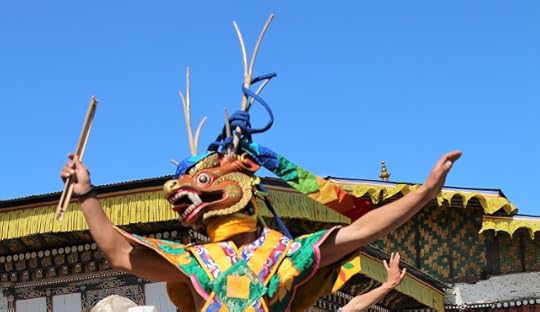
 The dances blend into one another and soon the arena is filled with mask dancers swirling and jumping, a flourish of colour and vitality. We have no idea what the story lines are or why so many incredible dancers fill the circle but we take delight in the spectacular.
The dances blend into one another and soon the arena is filled with mask dancers swirling and jumping, a flourish of colour and vitality. We have no idea what the story lines are or why so many incredible dancers fill the circle but we take delight in the spectacular.
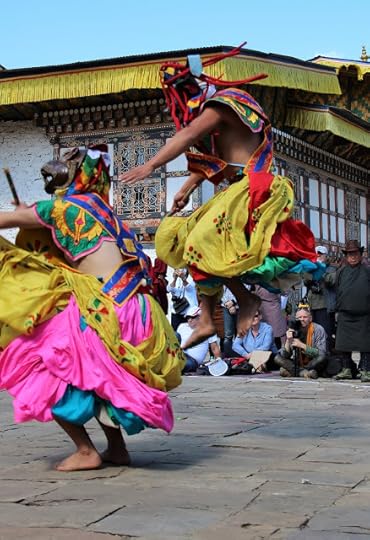 As the morning turns to afternoon we are transposed to another realm and become lost in the Lord of the Cremation Ground Dance (Durdag Cham) when masks of white skeletons dance in slow ethereal movements. At times they carry a large black cloth which holds a linga representing an evil spirit. The evil spirit is dissolved and sent to the pure land thus giving us, the spectators a mind free from obstructions and open to enlightenment. It's a beautiful dance and I am held spellbound.
As the morning turns to afternoon we are transposed to another realm and become lost in the Lord of the Cremation Ground Dance (Durdag Cham) when masks of white skeletons dance in slow ethereal movements. At times they carry a large black cloth which holds a linga representing an evil spirit. The evil spirit is dissolved and sent to the pure land thus giving us, the spectators a mind free from obstructions and open to enlightenment. It's a beautiful dance and I am held spellbound.
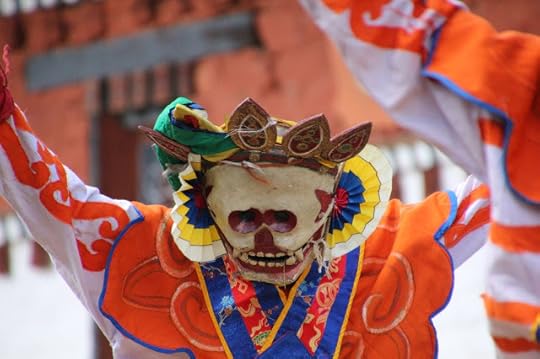
It is getting late and we are still to visit another festival, the Prakhar Tsechu which is held at the tiny Prakhar Goemba, a good half hour drive from Jakar. Our guide tells us that today is a practise day and that not much will be happening, there'll be no masks or costumes...all very quiet he says.

The Goemba is perched on a tiny hillock across from a river and it is a lovely ten minute walk from the road to it, across a swing bridge.

When we enter the courtyard of the Goemba, we are immediately held transfixed. There are only two other tourist and a handful of local Bhutanese - some children and elderly women - watching the trance like-dance being performed by magenta robed monks. Each of the monks hold a large drum in their hands. They appear to all be in meditative focus, their eyes closed tight, their mouths twisted as if in pain and peace at the very same time.
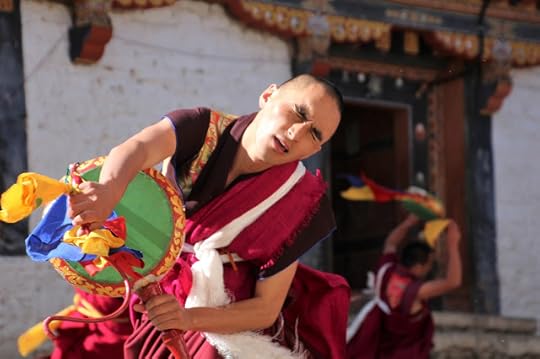
Mal and I take a seat on the grassy courtyard and watch. They are performing the Drametse Ngacham - the Drum Dance from Drametse. This dance was designated by UNESCO in 2005 as an 'Intangible Cultural Heritage of Humanity" - described as a tradition/living expression inherited from our ancestors and passed on to our descendants. An incredible dance it is considered to be sacred, symbolizing attainment and generating 'good karma to be reborn in paradise' and goes through a process of twenty-one sessions all performed in in a meditated state, focusing on the power of compassion and visualizing the nine stages of becoming enlightened. It is said that watching this dance in all its glory removes obstacles and brings peaceful activity to the spectators - and one's wishes will be fulfilled. I feel an incredible sense of peace as I am pulled into the beat of the drums and watch the monks spin and fly as if in another world, a world where peace is attained.

Published on January 07, 2016 06:18
December 26, 2015
From Madman to Naked Man

Over peanut-butter-jelly sandwiches and French fries with a side of rubbery fried eggs for breakfast we vow to learn how to open a door again and work on our flabby arms by carrying our own bags. An hour latter I'm stifling giggles as Mal luggage-wrestles again with petit house-keepers in crisp kiras of beautiful woven thread and high silk cuffed toegos.
 We leave a mist covered Punakha early and begin a long drive into dust clouds and bone-rattling ruts all the way to Jakar. The national highway that runs through the middle of Bhutan is undergoing major construction, turning it from dual lane to four lane - all at once! We're told by our guide that the government has given the contract to a company who in turn has contracted the work out to many smaller companies; all of which appear to be competition with each other as to who can make the road the most dug-up, rubble filled, need-a-monster-truck-to-drive-it road possible.
We leave a mist covered Punakha early and begin a long drive into dust clouds and bone-rattling ruts all the way to Jakar. The national highway that runs through the middle of Bhutan is undergoing major construction, turning it from dual lane to four lane - all at once! We're told by our guide that the government has given the contract to a company who in turn has contracted the work out to many smaller companies; all of which appear to be competition with each other as to who can make the road the most dug-up, rubble filled, need-a-monster-truck-to-drive-it road possible.
 I'm sure the country-side here is breath-takingly beautiful with abundant waterfalls cascading down the mountain side and plunging valleys filled with trees but mostly what we see is the colour of grey. The dust covers everything and when we stop for moment of clear sky I notice that there's a film of fine grey powder covering not only the whole outside of the car, but also all the luggage in the back the car and every crevices of the dash at the front. Even my nose also needs a good industrial blow out!
I'm sure the country-side here is breath-takingly beautiful with abundant waterfalls cascading down the mountain side and plunging valleys filled with trees but mostly what we see is the colour of grey. The dust covers everything and when we stop for moment of clear sky I notice that there's a film of fine grey powder covering not only the whole outside of the car, but also all the luggage in the back the car and every crevices of the dash at the front. Even my nose also needs a good industrial blow out!
 As well as all the construction work we need to navigate, our driver also has to hopscotch the tree-fellers along the road who are 'trimming' the sides. We witness lots of creative ways to cut overhanging branches from trees clinging to near vertical cliff-faces, there's absolutely no occupational health and safety here - cutters dangle themselves over the side of the cliffs, wedging their feet against trunks or branches as they saw away precariously with hand saws. Or whole trees are felled onto the road and gangs of cutters chop and cut great chunks of timber into rough blocks which they then lug into tip-trucks or just 'tossed' over the side of the road and down the mountain.
As well as all the construction work we need to navigate, our driver also has to hopscotch the tree-fellers along the road who are 'trimming' the sides. We witness lots of creative ways to cut overhanging branches from trees clinging to near vertical cliff-faces, there's absolutely no occupational health and safety here - cutters dangle themselves over the side of the cliffs, wedging their feet against trunks or branches as they saw away precariously with hand saws. Or whole trees are felled onto the road and gangs of cutters chop and cut great chunks of timber into rough blocks which they then lug into tip-trucks or just 'tossed' over the side of the road and down the mountain.
 Near Pele La (a pass of 3420mts) our driver adds dodging Yaks to his navigation skills. In the valley below herds of Yaks graze on green paddocks, some making their way to the roadside where they graze and lounge without a care in the world. They are gentle looking creatures, mostly black with a few sporting white tails, but according to our guide, wild yaks are dangerous and therefore we are unable to stop for a closer look. I find myself feeling a bit sceptical about this, but make do with taking my photos of these doe-eyed beasts from inside the car. We zip past a gorgeous little stupa that reminds me of the Boudanath Stupa in Nepal - it's beautiful - and before I can yell "Stop" our guide turns around from the front seat of the car and informs us that we'll stop here on the journey back from the east and off we continue.
Near Pele La (a pass of 3420mts) our driver adds dodging Yaks to his navigation skills. In the valley below herds of Yaks graze on green paddocks, some making their way to the roadside where they graze and lounge without a care in the world. They are gentle looking creatures, mostly black with a few sporting white tails, but according to our guide, wild yaks are dangerous and therefore we are unable to stop for a closer look. I find myself feeling a bit sceptical about this, but make do with taking my photos of these doe-eyed beasts from inside the car. We zip past a gorgeous little stupa that reminds me of the Boudanath Stupa in Nepal - it's beautiful - and before I can yell "Stop" our guide turns around from the front seat of the car and informs us that we'll stop here on the journey back from the east and off we continue.
 We do stop however at Pele La where we jump out for a quick once around the Chorten in the middle of the road, and string a line of prayer flags to join all the other colourful flapping good wishes, then off we go again. The road works are getting worse as we bump along and just as I'm bemoaning about my sore backside I take notice of the blue tarped and corrugated iron humpys that dot parts of the roadworks. When I first saw these huts I thought they may be equipment storage huts, but as I peered into an open door of one as we pass I am horrified to see bedding and woman and child sitting on the floor. "People live in there?" I ask the guide. He shrugs and says yes, the workers and sometimes their families join them. He explains to us that many of the road workers are Indian citizens "Bhutanese people don't like to do menial work" he explains " many are well educated, this type of work is below them." I find it hard to comprehend how the ethos of Gross National Happiness this country lives by correlates to the working and living conditions of these workers and their families. I also find myself wondering about the health effects on the workers and their families with all the dust that fills the air - surely their lungs and eyes must suffer greatly.
We do stop however at Pele La where we jump out for a quick once around the Chorten in the middle of the road, and string a line of prayer flags to join all the other colourful flapping good wishes, then off we go again. The road works are getting worse as we bump along and just as I'm bemoaning about my sore backside I take notice of the blue tarped and corrugated iron humpys that dot parts of the roadworks. When I first saw these huts I thought they may be equipment storage huts, but as I peered into an open door of one as we pass I am horrified to see bedding and woman and child sitting on the floor. "People live in there?" I ask the guide. He shrugs and says yes, the workers and sometimes their families join them. He explains to us that many of the road workers are Indian citizens "Bhutanese people don't like to do menial work" he explains " many are well educated, this type of work is below them." I find it hard to comprehend how the ethos of Gross National Happiness this country lives by correlates to the working and living conditions of these workers and their families. I also find myself wondering about the health effects on the workers and their families with all the dust that fills the air - surely their lungs and eyes must suffer greatly.
 We arrive on the late side of noon to Trongsa - a town located in the very middle of Bhutan and the power rise of Bhutan's Monarchy. The first kings father, Jigme Namgyal, moved to the area and rose to power in the late 1800's and ever since each of the kings prior to taking the throne are required to undertake a stint as governor (penlop) of Trongsa. The Dzonng of Trongsa is enormous and one of the most spectacularly positioned buildings in the whole of Bhutan, perched on the side of mountain overlooking a gorge with ancient trails.
We arrive on the late side of noon to Trongsa - a town located in the very middle of Bhutan and the power rise of Bhutan's Monarchy. The first kings father, Jigme Namgyal, moved to the area and rose to power in the late 1800's and ever since each of the kings prior to taking the throne are required to undertake a stint as governor (penlop) of Trongsa. The Dzonng of Trongsa is enormous and one of the most spectacularly positioned buildings in the whole of Bhutan, perched on the side of mountain overlooking a gorge with ancient trails.
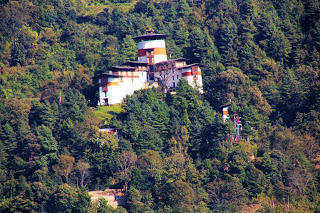 Behind it sits the watchtower and our lunch stop. Our weary bone-rattled bodies can barely make the few steps up to the Tower restaurant and when we sit down to eat, I have to admit we wonder why we bothered - the food is dreadful. I really cannot understand how an Asian/subcontinent country whose traditional dish is chock full of chillies, can cook meals so lack-lustre in taste. It doesn't take us long to eat, our meal consists more of a beer than food and then we make way to the Royal Heritage Museum to view among the many treasures, the Raven Crown. The official crown of the king of Bhutan, the one sitting on display in the museum is a stunning piece of craftsmanship and needlework. And if I may be so cheeky to suggest - also an outstanding piece of sugar skull art! The building is beautifully preserved full of winding stars and strange tiered floors and we are banned from taking our cameras into the building and leave them at the 'front' of the tower. We are directed to follow a maze of floors and as we near the end, our guide tells us he will double back to collect our cameras and bags. Just as we're about to exit the back door, a museum official indicates that we should go up a set of stairs to the viewing platform. We head up and are awarded a fabulous view of the Dzong and valley - stunning!
Behind it sits the watchtower and our lunch stop. Our weary bone-rattled bodies can barely make the few steps up to the Tower restaurant and when we sit down to eat, I have to admit we wonder why we bothered - the food is dreadful. I really cannot understand how an Asian/subcontinent country whose traditional dish is chock full of chillies, can cook meals so lack-lustre in taste. It doesn't take us long to eat, our meal consists more of a beer than food and then we make way to the Royal Heritage Museum to view among the many treasures, the Raven Crown. The official crown of the king of Bhutan, the one sitting on display in the museum is a stunning piece of craftsmanship and needlework. And if I may be so cheeky to suggest - also an outstanding piece of sugar skull art! The building is beautifully preserved full of winding stars and strange tiered floors and we are banned from taking our cameras into the building and leave them at the 'front' of the tower. We are directed to follow a maze of floors and as we near the end, our guide tells us he will double back to collect our cameras and bags. Just as we're about to exit the back door, a museum official indicates that we should go up a set of stairs to the viewing platform. We head up and are awarded a fabulous view of the Dzong and valley - stunning!
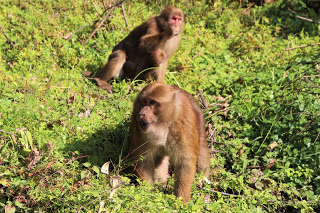 As we wander back down the spiral stairs our guide runs smack-bang into us, thinking something is wrong we ask if there is a problem, but instead he looks embarrassed and we realise that he doesn't want us 'wandering about' by ourselves. Back at the car, we're told there is no time to look at the Dzong, that we'll stop on the way back from the east. I'm seeing a big lists of things to see on the way back on a very long drive - I also see we'll be missing a lot of them again! We wave goodbye to cheeky monkeys striding near the tower's carpack and back on the road, bumping along to Jakar. As we near the township our guide informs us that there is not much to Jakar and that we'll be staying in the Chokhor Valley, a distance from the town. I find this information about Jake strange and read what the guide book says about Jakar to our guide, but he insists there is nothing to see in the town itself. We soon reach Jakar and instantly I love it - it's a quaint little place, bustling with life and lots of colourful shops, tucked in a valley and straddling the Chamkhar Chuu- I'm eager to explore it but instead we must drive through and off into the countryside to get to our hotel for the night. Again I'm far from impressed about being roomed so far away from the town.
As we wander back down the spiral stairs our guide runs smack-bang into us, thinking something is wrong we ask if there is a problem, but instead he looks embarrassed and we realise that he doesn't want us 'wandering about' by ourselves. Back at the car, we're told there is no time to look at the Dzong, that we'll stop on the way back from the east. I'm seeing a big lists of things to see on the way back on a very long drive - I also see we'll be missing a lot of them again! We wave goodbye to cheeky monkeys striding near the tower's carpack and back on the road, bumping along to Jakar. As we near the township our guide informs us that there is not much to Jakar and that we'll be staying in the Chokhor Valley, a distance from the town. I find this information about Jake strange and read what the guide book says about Jakar to our guide, but he insists there is nothing to see in the town itself. We soon reach Jakar and instantly I love it - it's a quaint little place, bustling with life and lots of colourful shops, tucked in a valley and straddling the Chamkhar Chuu- I'm eager to explore it but instead we must drive through and off into the countryside to get to our hotel for the night. Again I'm far from impressed about being roomed so far away from the town.
 The next day we're up early and hitting the Festival trail. Today is the first day of the Jambay Lhakhang Drup. The festival is held in a small temple called Jambay Lhakhang and is located in the heart of the Jakar valley. built in the early 7th century, the temple is dedicated to the 'Buddha of the future' - Maitreya - and holds an annual consecration ceremony (unlike a normal consecrate at a temple or church once and that's it) with the highlight being the Naked Dance or Dorling Tercham as is its official name. The temple is delightful, and when we arrive is a hive of activity with preparations in full swing. Men (in full ghos) are on the rooves hanging fabric valances, next door to the temple a paddock is being turned into a market place with makeshift huts going up and tantalizing smells wafting through of roasting meats and lots of chili cheese being cooked.
The next day we're up early and hitting the Festival trail. Today is the first day of the Jambay Lhakhang Drup. The festival is held in a small temple called Jambay Lhakhang and is located in the heart of the Jakar valley. built in the early 7th century, the temple is dedicated to the 'Buddha of the future' - Maitreya - and holds an annual consecration ceremony (unlike a normal consecrate at a temple or church once and that's it) with the highlight being the Naked Dance or Dorling Tercham as is its official name. The temple is delightful, and when we arrive is a hive of activity with preparations in full swing. Men (in full ghos) are on the rooves hanging fabric valances, next door to the temple a paddock is being turned into a market place with makeshift huts going up and tantalizing smells wafting through of roasting meats and lots of chili cheese being cooked.
 In another building tables filled with butter lamps burn brightly and when we walk in there we can only bear to stay a few minutes as the heat is extreme and the smell from the burning wicks saps away breath. But it still looks wonderful. After exploring the temple and its surrounds we take a walk through rural farmlands to a group of temples sitting near a small hill. These are called the Kurjey Lhakhang - a complex of three temples surrounded by 108 chortens, each of the temples are beautiful, but its the last temple, highest up in the complex that I find the most special.
In another building tables filled with butter lamps burn brightly and when we walk in there we can only bear to stay a few minutes as the heat is extreme and the smell from the burning wicks saps away breath. But it still looks wonderful. After exploring the temple and its surrounds we take a walk through rural farmlands to a group of temples sitting near a small hill. These are called the Kurjey Lhakhang - a complex of three temples surrounded by 108 chortens, each of the temples are beautiful, but its the last temple, highest up in the complex that I find the most special.
 Upon entering the inner sanctum I find that a group of monks are chanting and many people are meditating. I join them, mainly for the need to regain touch with my inner self, but also to find peace from the claustrophobic attention our guide is bestowing upon us. I am suffocating from his intense attention and constant watching eyes. I don't know how long I sat there staring into my navel, but soon it was time to leave as poor Mal was sitting outside under the Bhodi tree - he was totally 'templed-out' and had decided to sit this one out. I took a quick peek at the treasure of this temple - the hollow impression of Guru Rinpoche (apparently he sat so long in meditation that he left an indent in the rock. When I meet up with Mal again I agree with him that at this very moment, I too am templed out and that we should go in search of a beer and try some cheese. Jakar is famous also for it's Panda Beer of which its brewery is next door to the cheese factory. We tell the guide we'd like to go there, but he takes us to another temple first where we are encouraged to put on some chain-mail and try and make three coras of the temple.
Upon entering the inner sanctum I find that a group of monks are chanting and many people are meditating. I join them, mainly for the need to regain touch with my inner self, but also to find peace from the claustrophobic attention our guide is bestowing upon us. I am suffocating from his intense attention and constant watching eyes. I don't know how long I sat there staring into my navel, but soon it was time to leave as poor Mal was sitting outside under the Bhodi tree - he was totally 'templed-out' and had decided to sit this one out. I took a quick peek at the treasure of this temple - the hollow impression of Guru Rinpoche (apparently he sat so long in meditation that he left an indent in the rock. When I meet up with Mal again I agree with him that at this very moment, I too am templed out and that we should go in search of a beer and try some cheese. Jakar is famous also for it's Panda Beer of which its brewery is next door to the cheese factory. We tell the guide we'd like to go there, but he takes us to another temple first where we are encouraged to put on some chain-mail and try and make three coras of the temple.
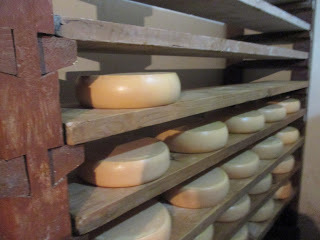 I can't even lift it, but Mal gives it a go and does the coras without breaking a sweat. We then make haste to the brewery only to find they are not undertaking tours or tasting, we have to buy a full bottle to try. This of course doesn't perturb Mal any, but when he takes his first sip, the noes is wrinkled up and a tight lip pull is formed. We then pop across to the cheese factory and enjoy a small tour of the factory - unfortunately for me, the cheese misses the mark a little - although it's more like a swiss style cheese, I find I've become quite taken with the Bhutan style of feta instead. I'm still not game enough to try the rock-hard little square cheeses we see strung up like curtain-streamers though.
I can't even lift it, but Mal gives it a go and does the coras without breaking a sweat. We then make haste to the brewery only to find they are not undertaking tours or tasting, we have to buy a full bottle to try. This of course doesn't perturb Mal any, but when he takes his first sip, the noes is wrinkled up and a tight lip pull is formed. We then pop across to the cheese factory and enjoy a small tour of the factory - unfortunately for me, the cheese misses the mark a little - although it's more like a swiss style cheese, I find I've become quite taken with the Bhutan style of feta instead. I'm still not game enough to try the rock-hard little square cheeses we see strung up like curtain-streamers though.
 Later that evening we head back to Jambay Lhakhang where we find the place absolutely teaming with people and totally unable to get anywhere near the action is taking place. We stand on tippy-toes and hold our cameras high above our heads in hope to catch something of the dancing that is taking place (and then look at it later) but it is not until the crowd starts following a group of fire holders that we snaffle a spot near the ring. Unfortunately there is nothing to watch as now all the action is taking place in a field on the other side of the temple.
Later that evening we head back to Jambay Lhakhang where we find the place absolutely teaming with people and totally unable to get anywhere near the action is taking place. We stand on tippy-toes and hold our cameras high above our heads in hope to catch something of the dancing that is taking place (and then look at it later) but it is not until the crowd starts following a group of fire holders that we snaffle a spot near the ring. Unfortunately there is nothing to watch as now all the action is taking place in a field on the other side of the temple.
 Malcolm wanders over to see what is going on while I 'stand guard' over our new-found spots. Turns out the Mewang was taking place - the fire offering. Mal comes back all excited and tells me about how a 'bough' exploded into flames and everyone, including people carrying children on their shoulders ran under the sprays of embers. It also turned out that just prior to the lighting of the bough, the black hat dance had taken place (an absolute highlight!) and we had missed it, although I did get a photo of a chap in his glorious outfit as he passed me on the way back to the 'green room'. By this stage it was close to midnight and I was freezing, the temperature had dropped to frigid and try as I might, I just couldn't keep the teeth from chattering . As we readied to go, the Naked Man stormed into the ring to show off their rings to the crowds and I can see it wasn't just my teeth that were feeling the cold.
Malcolm wanders over to see what is going on while I 'stand guard' over our new-found spots. Turns out the Mewang was taking place - the fire offering. Mal comes back all excited and tells me about how a 'bough' exploded into flames and everyone, including people carrying children on their shoulders ran under the sprays of embers. It also turned out that just prior to the lighting of the bough, the black hat dance had taken place (an absolute highlight!) and we had missed it, although I did get a photo of a chap in his glorious outfit as he passed me on the way back to the 'green room'. By this stage it was close to midnight and I was freezing, the temperature had dropped to frigid and try as I might, I just couldn't keep the teeth from chattering . As we readied to go, the Naked Man stormed into the ring to show off their rings to the crowds and I can see it wasn't just my teeth that were feeling the cold.
Published on December 26, 2015 03:56
December 11, 2015
Ten, nine, eight.... LAUNCH !!!!!!!!!!
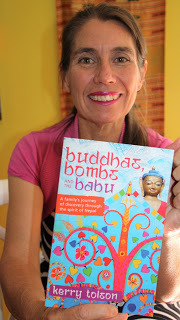 It's here and happening, right now! And I'm as nervous as can be. Tomorrow I stand up for all the world to see. Well maybe not all the world, but definitely a few passer-bys. What am I talking about you ask? Well I'm proud to write but terrified to say... Buddhas, Bombs and the Babu is no longer a dream but a reality, it's a bright, sparkly, shiny cover wrapped around 80,000 words with a beginning and an ending and riotous trip stumbling through Nepal in the middle. And tomorrow I do my very first Author Appearance and signing.
It's here and happening, right now! And I'm as nervous as can be. Tomorrow I stand up for all the world to see. Well maybe not all the world, but definitely a few passer-bys. What am I talking about you ask? Well I'm proud to write but terrified to say... Buddhas, Bombs and the Babu is no longer a dream but a reality, it's a bright, sparkly, shiny cover wrapped around 80,000 words with a beginning and an ending and riotous trip stumbling through Nepal in the middle. And tomorrow I do my very first Author Appearance and signing. But for a moment indulge me as I take you back to last week, just after we arrived back home from Nepal.... yes I know, I haven't posted anything on Nepal yet...at the moment I'm running late with my Bhutan posts... and Nepal is next, but just for the moment I'm going to steal a post (or two) to tell you how excited I was to arrive home and find my author copies of Buddhas, Bombs and the Babu waiting for me - all 400.
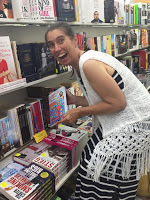 I opened the first box and stared at the lovely cover, bright and vibrant. I love this cover so much. The image was painted especially for the book, by a wonderful North Coast artist - Donna Sharam - and it represents every thing that is quintessential Nepal; colour, life, strength and vibrancy. Then it was down to work - within 24hours of arriving home, I'd thrown a couple of boxes into the car and was making a trip around to the book shops in my area - Byron, Bangalow, Ballina....Lismore - in the hope to sell a few. I couldn't offload a one. Not even a single page! Was I disappointed? Not at all... because they had all ordered in the book and there it was, sitting on the bookshelves. I could hardly contain my excitement.
I opened the first box and stared at the lovely cover, bright and vibrant. I love this cover so much. The image was painted especially for the book, by a wonderful North Coast artist - Donna Sharam - and it represents every thing that is quintessential Nepal; colour, life, strength and vibrancy. Then it was down to work - within 24hours of arriving home, I'd thrown a couple of boxes into the car and was making a trip around to the book shops in my area - Byron, Bangalow, Ballina....Lismore - in the hope to sell a few. I couldn't offload a one. Not even a single page! Was I disappointed? Not at all... because they had all ordered in the book and there it was, sitting on the bookshelves. I could hardly contain my excitement. 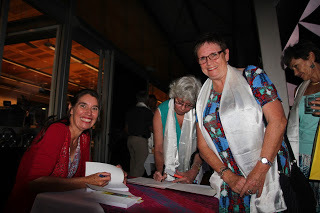 Books in shops, it was time to have the Launch Party, which went off with a bang last Thursday. I was terrified no-one would turn up. Well I knew Mal would turn up - he had too or it would have been pretty frosty at home. And I knew Seb and GG would be there; especially if they wanted free babysitting, but I was worried no one else would come.
Books in shops, it was time to have the Launch Party, which went off with a bang last Thursday. I was terrified no-one would turn up. Well I knew Mal would turn up - he had too or it would have been pretty frosty at home. And I knew Seb and GG would be there; especially if they wanted free babysitting, but I was worried no one else would come.  I'd booked the wonderful restaurant at our local TAFE institution - The Nightcap Restaurant - for the Launch Event where they were to serve the most delicious canapés and yummies and promised to ply everyone with wine for me. The incredible Samba Blissters were to roll the book out with a bang and an art exhibition by the cover artist herself - Donna Sharam - would add extra colour and vitality to the night. As I watched the clock tick over while I unloaded the goodie bags and Kata scarfs I'd brought back from Nepal, I prayed to the bodhisattvas to shine their blessings down on me. On the dot of six, the car park began to fill and lines of guests made their way up the path to be greeted with a Kata and a wish of "Happy Journeys - where ever you may travel in life".
I'd booked the wonderful restaurant at our local TAFE institution - The Nightcap Restaurant - for the Launch Event where they were to serve the most delicious canapés and yummies and promised to ply everyone with wine for me. The incredible Samba Blissters were to roll the book out with a bang and an art exhibition by the cover artist herself - Donna Sharam - would add extra colour and vitality to the night. As I watched the clock tick over while I unloaded the goodie bags and Kata scarfs I'd brought back from Nepal, I prayed to the bodhisattvas to shine their blessings down on me. On the dot of six, the car park began to fill and lines of guests made their way up the path to be greeted with a Kata and a wish of "Happy Journeys - where ever you may travel in life".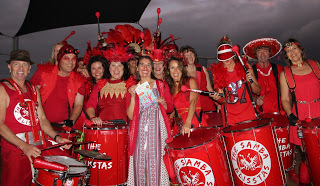
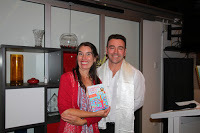 It was an amazing night with over 100 people attending - including my Publisher - Mark Zocchi of Brolga Publishing, who announced on the night, to my absolute surprise and delight, that the book had been sold into the UK. Talk about shrieks of delight!
It was an amazing night with over 100 people attending - including my Publisher - Mark Zocchi of Brolga Publishing, who announced on the night, to my absolute surprise and delight, that the book had been sold into the UK. Talk about shrieks of delight! And now it's time for the tours of the bookstores. The lovely little book shop of Books@Stones, at Logan Road, Stones Corner is my host for my first ever book signing and author appearance and I'm very excited to be visiting this bookstore just 4kms from the very heart of Brisbane's CBD and located in the village atmosphere of Stones Corner. I can't wait to spread out the beautiful covers for all to see...plus I have a chocky or two to entice

Published on December 11, 2015 06:03
November 28, 2015
Chasing a Madman
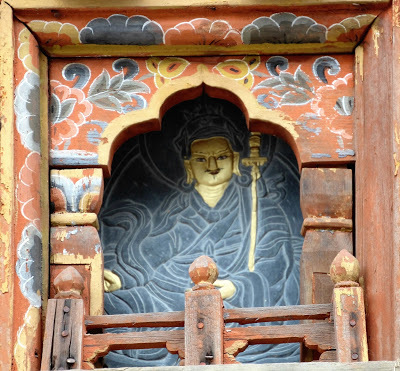
We're off to meet a madman today, though the way I'm feeling, I'm not sure if the madman would like to meet with an 'off with the fairies' lady. It was a hellish night in our hotel at Thimphu with lots of groaning, banging of doors and running in and out of rooms - and that was just in our room. Outside in the hallway and stairwell it was all yelling, squealing and I'm sure, stair-master time.... judging by all the pounding feet up and down the endless levels of stairs. My earlier headache and unease back in Haa and Paro had morphed into full blown 'cranial crush', 'gut groan' and butt... well put it this way, I was visiting the little room more times than I cared too. As the sun rose, I emerged looking like I'd had a heavy night - grog-eyed and stumbly without the enjoyment of indulging in a glass or two.
Our guide meets us in the foyer and suggests a short hike up a hill then down dale to the Motithang Preserve - I suggest a lay in the back seat while we drive there - this doesn't impress the guide any and he comments that I need to be doing these little hikes to get fit for Tigers Nest which we are to do at the end of our trip. As much as I could see his point, I was actually flat out seeing anything as my head is pounding and just to open my eyes actually hurts. I stumble out to the car and lay prone as the usual luggage tug-a-war eventuates between Mal and the hotel girls - they win again.
 First stop for the day is the Motithang Takin Preserve where we are to see the 'handiwork' of the Divine Madman. The Divine Madman - Lama Drukpa Kunley - is a Bhutan saint of great reverence, but he was also a 'kidder' with outrageous humour and 'crazy wisdom' and it is said that he magically produced the Takin, the national animal of Bhutan. After eating a whole cow and a whole goat, he put the bones together to make a single animal.
First stop for the day is the Motithang Takin Preserve where we are to see the 'handiwork' of the Divine Madman. The Divine Madman - Lama Drukpa Kunley - is a Bhutan saint of great reverence, but he was also a 'kidder' with outrageous humour and 'crazy wisdom' and it is said that he magically produced the Takin, the national animal of Bhutan. After eating a whole cow and a whole goat, he put the bones together to make a single animal. The Takin we are visiting were from the original zoo of Bhutan which was dismantled by the Fourth King in keeping with the philosophy of Buddhism and all the animals set free. The Takin however were so tame they refused to 'run away to the bush' and instead wandered around the city of Thimphu, getting in the way, searching for food, lounging on the roadway and generally causing mayhem, so they were returned to the zoo which was made into a reservation for them... along with some deer.
 Just down the road we come across a lively game of darts - Bhutanese style. Called Khuru, the dart is an enormous timber ball with a long metal bar that looks like a lethal nail and is thrown with great gusto at a target about twenty meters or so away ('stabbed' into the ground very similar to the archery target) while people stand infront of it.
Just down the road we come across a lively game of darts - Bhutanese style. Called Khuru, the dart is an enormous timber ball with a long metal bar that looks like a lethal nail and is thrown with great gusto at a target about twenty meters or so away ('stabbed' into the ground very similar to the archery target) while people stand infront of it.
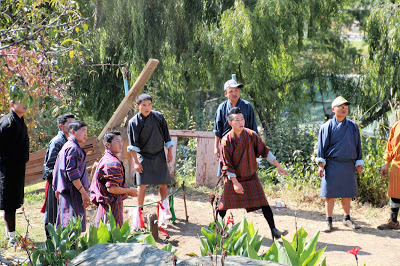 As in Archery, a lot of intensity and concentration goes into it and just like archery, there's a lot of song and dance too. And bravado as we watch to spectators jump out of the way of the flung dart...crazy is not the word.
As in Archery, a lot of intensity and concentration goes into it and just like archery, there's a lot of song and dance too. And bravado as we watch to spectators jump out of the way of the flung dart...crazy is not the word.The Wang Chuu falls away are we climb out of the valley that holds Thimphu and drive up towards Dochu La, past a small village and roadside stalls selling baskets and baskets of apples. Dochu La soon comes into viw - a vision of white and red brick shimmering against a 'confettied' blue sky.
 One hundred and white chortens encircled with strands and strands of prayer flags. Built in 2005 as a memorial to those who died in 2003 battle against the Assamese Separatists from India. Dochu La is also a hive of activity with multitudes of cars, busses, and trucks parked in the middle of the road and a throng of bodies milling about, taking photos of each other, of the chortens and of a large building sitting out a hill that looks like a museum. Last night we had purchased a set of five prayer flags and I'm keen to add to the swathe of flags already covering the woodland and hillside beside the Chortens. Just before I get out of the car, I hand a roll of prayer flags to our driver - had had shared with me earlier as we walked from the Taken enclosure, that his sister-in-law had passed away, just that morning. We are devastated for him and I immediately suggest to him that he go be with his family, and I will ask the tour company for a 'step-in' driver until he returns, but he has declined. Now I hand him the flags - although a small gesture, I hope it will convey our sincere condolences. Mal and I follow our guide up the hill, under the strands of glorious colour to where a group of men are chanting around a small fire. "they are saying prayers" our guide tells us and we are just about to move away, when one fellow rises and gestures to us to come over and hang our flags in the wisps of smoke. "How auspicious" I whisper and eagerly unfurl the flags. As I hand one end to Mal, our guide takes it from him and directs me to stand near a tree, he ties the end he's taken, I turn and go to tie mine, but before I have a chance to finish the knot he takes the cord from me and proceeds to tie it. I'm far from impressed and feel a flash of anger - something I would never want associated with such a sacred piece. The beautiful moment is gone. Mal has already turned and is heading back to the car park, he too is far from happy.
One hundred and white chortens encircled with strands and strands of prayer flags. Built in 2005 as a memorial to those who died in 2003 battle against the Assamese Separatists from India. Dochu La is also a hive of activity with multitudes of cars, busses, and trucks parked in the middle of the road and a throng of bodies milling about, taking photos of each other, of the chortens and of a large building sitting out a hill that looks like a museum. Last night we had purchased a set of five prayer flags and I'm keen to add to the swathe of flags already covering the woodland and hillside beside the Chortens. Just before I get out of the car, I hand a roll of prayer flags to our driver - had had shared with me earlier as we walked from the Taken enclosure, that his sister-in-law had passed away, just that morning. We are devastated for him and I immediately suggest to him that he go be with his family, and I will ask the tour company for a 'step-in' driver until he returns, but he has declined. Now I hand him the flags - although a small gesture, I hope it will convey our sincere condolences. Mal and I follow our guide up the hill, under the strands of glorious colour to where a group of men are chanting around a small fire. "they are saying prayers" our guide tells us and we are just about to move away, when one fellow rises and gestures to us to come over and hang our flags in the wisps of smoke. "How auspicious" I whisper and eagerly unfurl the flags. As I hand one end to Mal, our guide takes it from him and directs me to stand near a tree, he ties the end he's taken, I turn and go to tie mine, but before I have a chance to finish the knot he takes the cord from me and proceeds to tie it. I'm far from impressed and feel a flash of anger - something I would never want associated with such a sacred piece. The beautiful moment is gone. Mal has already turned and is heading back to the car park, he too is far from happy.
 Back at the carpark Mal had come across a group of people dressed in bright orange, at first we thing they are defence, but soon learn they are the DeSuung Volunteers (Guardians of Peace and Harmony) and serve the nation and community is times of disasters and community events. I'm eager to also go up to the building on the other side of the carpark where a lot of people are wondering up to but our guide tells us we need to get moving. We have much to do.
Back at the carpark Mal had come across a group of people dressed in bright orange, at first we thing they are defence, but soon learn they are the DeSuung Volunteers (Guardians of Peace and Harmony) and serve the nation and community is times of disasters and community events. I'm eager to also go up to the building on the other side of the carpark where a lot of people are wondering up to but our guide tells us we need to get moving. We have much to do.
 The bitumen road soon becomes a dirt track and we find ourselves driving along the National Highway in full construction mode. It's a bumpy dusty ride as well as exceedingly slow and we reach a small village called Sopsokha on the late side of lunchtime.
The bitumen road soon becomes a dirt track and we find ourselves driving along the National Highway in full construction mode. It's a bumpy dusty ride as well as exceedingly slow and we reach a small village called Sopsokha on the late side of lunchtime. 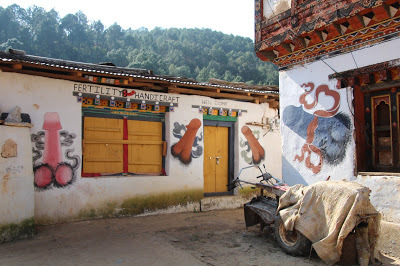 As we alight the car our eyes almost jump out of our heads - the whole town is decorated in phalluses of all sizes, colours, and differing dancing stances. I want to explore and photograph the colour and hilarity but we are whisked off the restaurant to eat. The food is a bland version of Continental done so badly, vegemite on ricecrackers is a tastier choice. Lunch done I bound out to find the nearest dancing dick, but our guide tells me we have little time and need to take a walk through the rice fields to a temple sitting on a far side of the hillock - Chhimi Lhakhang - the temple that had been blessed by the Divine Madman after he had lulled a demoness with his magic 'thunderbolt' (hmmm, an interesting moniker for it). We wander through the fields, watching the men thrashing the rice while the women lay the sheafs in rows.
As we alight the car our eyes almost jump out of our heads - the whole town is decorated in phalluses of all sizes, colours, and differing dancing stances. I want to explore and photograph the colour and hilarity but we are whisked off the restaurant to eat. The food is a bland version of Continental done so badly, vegemite on ricecrackers is a tastier choice. Lunch done I bound out to find the nearest dancing dick, but our guide tells me we have little time and need to take a walk through the rice fields to a temple sitting on a far side of the hillock - Chhimi Lhakhang - the temple that had been blessed by the Divine Madman after he had lulled a demoness with his magic 'thunderbolt' (hmmm, an interesting moniker for it). We wander through the fields, watching the men thrashing the rice while the women lay the sheafs in rows. 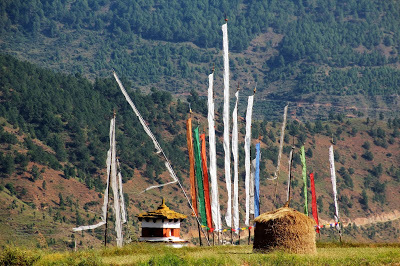 It's beautiful scenery, pretty green fields dotted with golden hay stacks resembling small stupas with their spire top and waving poles of white remembrance prayer flags. We arrive to the temple and find a crowd of people enjoying the beautiful scenery and a large bohdi tree, it's enormous canopy and stone sitting area offering a cool respite from the afternoon sun. Also there is Colin, having just received a 'bop' on the head from a monk who used an ivory phallus and the Divine Madman's bow and arrow, along with a name for his soon to be born baby. He tells us the name and it has a poetic ring. He's already rung his wife with the news. We all leave the temple together and wander back towards Sopsokha, chatting about babies and parenthood. Our guide calls our names and indicates to us that we are going to walk in another direction through the rice terraces so we bade Colin a farewell and traipse into the fields. To our astonishment we then turn, climb up a terrace and walk almost parallel to the road. And to Colin. But we are too far up to continue our conversation. I cannot believe what has happen - our guide has just isolated us. Again. Mal and I had noted this on another occasion, in a restaurant when we were directed to sit at the far end of the room, away from all the other tourists. At the time we thought it a little strange, but this was so obvious. We returned to the village and the carpark, waved goodbye to Colin and continued on to visit the beautiful Punakha Dzong.
It's beautiful scenery, pretty green fields dotted with golden hay stacks resembling small stupas with their spire top and waving poles of white remembrance prayer flags. We arrive to the temple and find a crowd of people enjoying the beautiful scenery and a large bohdi tree, it's enormous canopy and stone sitting area offering a cool respite from the afternoon sun. Also there is Colin, having just received a 'bop' on the head from a monk who used an ivory phallus and the Divine Madman's bow and arrow, along with a name for his soon to be born baby. He tells us the name and it has a poetic ring. He's already rung his wife with the news. We all leave the temple together and wander back towards Sopsokha, chatting about babies and parenthood. Our guide calls our names and indicates to us that we are going to walk in another direction through the rice terraces so we bade Colin a farewell and traipse into the fields. To our astonishment we then turn, climb up a terrace and walk almost parallel to the road. And to Colin. But we are too far up to continue our conversation. I cannot believe what has happen - our guide has just isolated us. Again. Mal and I had noted this on another occasion, in a restaurant when we were directed to sit at the far end of the room, away from all the other tourists. At the time we thought it a little strange, but this was so obvious. We returned to the village and the carpark, waved goodbye to Colin and continued on to visit the beautiful Punakha Dzong. 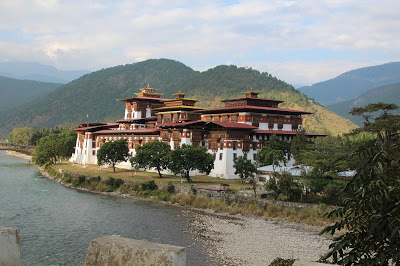
It's magnificent. Sitting next to a coursing river of the most vibrant green, it's claimed to be the 'most beautiful' Dzong in Bhutan. It's definitely got the most beautiful scenery surrounding it. We stop near the fork of the river and I go to get out of the car to photograph the scene. Our guide is at the car door taking my camera as I step out. I tell him it's right, I can carry it but he insists on taking it - across the road. Then he raises it and takes the photo. I'm flabbergasted.
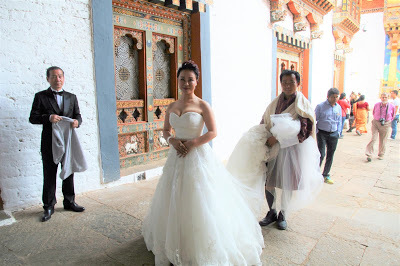 Inside the Dzong is stunning in every way, incredible artwork, gloriously entwined iron lacework and timber with mother-of-pearl inlay. As we wander through the corridors we turn a corner and come across a wedding being photographed. I love how every country I stumble through I stumble upon a beautiful bride. And here she was looking exquisite against the beauty of the magnificent whitewashed walls glinting with gold and red.
Inside the Dzong is stunning in every way, incredible artwork, gloriously entwined iron lacework and timber with mother-of-pearl inlay. As we wander through the corridors we turn a corner and come across a wedding being photographed. I love how every country I stumble through I stumble upon a beautiful bride. And here she was looking exquisite against the beauty of the magnificent whitewashed walls glinting with gold and red.
 We leave the Dzong and make our way towards an enormous swing bridge. It's high and long but I get the jellies even thinking of walking across it so I remain at the car while Mal and our guide go for a 'swing'.
We leave the Dzong and make our way towards an enormous swing bridge. It's high and long but I get the jellies even thinking of walking across it so I remain at the car while Mal and our guide go for a 'swing'.
 The air is cooling and the afternoon shadows become long. It's too late to see any of the town of Punakha so we head to our hotel which turns out to be a good half hour drive from Punakha, or anywhere else we notice, our hotel overlooks the river and rice fields and is well away from any towns. It’s very pretty, but isolated. Just as we are following two very tiny woman lug our enormous bags up rows of steps and paths to our room, our guide informs us he has just received a phone call from our previous hotel in Thimphu. I'm horrified to learn I've left my laptop there. In my earlier groggy state of altitude haze, I'd left it sitting on the table in the hotel's foyer. Where's a Divine Madman when you need one...
The air is cooling and the afternoon shadows become long. It's too late to see any of the town of Punakha so we head to our hotel which turns out to be a good half hour drive from Punakha, or anywhere else we notice, our hotel overlooks the river and rice fields and is well away from any towns. It’s very pretty, but isolated. Just as we are following two very tiny woman lug our enormous bags up rows of steps and paths to our room, our guide informs us he has just received a phone call from our previous hotel in Thimphu. I'm horrified to learn I've left my laptop there. In my earlier groggy state of altitude haze, I'd left it sitting on the table in the hotel's foyer. Where's a Divine Madman when you need one...
Published on November 28, 2015 06:19
November 18, 2015
Food for thought - "were you ever happy?"
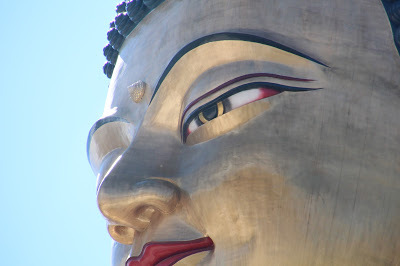
 Happiness appears to be all around, even the graffiti in Bhutan exudes messages of joy and positivity – soulful scribble. “Different is beautiful” and “Never let go of your dreams” whisper to us from the side walls of the shops. Around one corner I’m delighted to spy an advertising slogan of “get enlightened, read a book” in front of a small bookshop and then a few meters away a smiley face and rainbow with “lets all read”.
Happiness appears to be all around, even the graffiti in Bhutan exudes messages of joy and positivity – soulful scribble. “Different is beautiful” and “Never let go of your dreams” whisper to us from the side walls of the shops. Around one corner I’m delighted to spy an advertising slogan of “get enlightened, read a book” in front of a small bookshop and then a few meters away a smiley face and rainbow with “lets all read”.
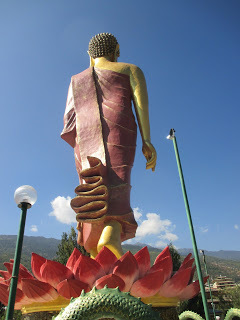 Over breakfast we read our itinerary and decided there’s too much packed in for such a short time frame – 1 day, which isn’t due to begin until at least 9am. There’s a few-hours-hike to a monastery, three museums, three temples, a Dzong, the weekend market, and later in the evening – the one thing we definitely earmarked for our tour - and are really looking forward too - a cooking class. We’re not ‘go and tick it off’ people and so we narrow it down to the weekend market, the Giant Buddha and the Dzong, with our cooking class in the evening. When we meet our guide and tell him our plans along with wanting to have the whole of the afternoon to wander by ourselves in Thimphu so we can do some shopping and chill at Ambient Café, our guide is a little confused – most tourist want to see it all he tells us.
Over breakfast we read our itinerary and decided there’s too much packed in for such a short time frame – 1 day, which isn’t due to begin until at least 9am. There’s a few-hours-hike to a monastery, three museums, three temples, a Dzong, the weekend market, and later in the evening – the one thing we definitely earmarked for our tour - and are really looking forward too - a cooking class. We’re not ‘go and tick it off’ people and so we narrow it down to the weekend market, the Giant Buddha and the Dzong, with our cooking class in the evening. When we meet our guide and tell him our plans along with wanting to have the whole of the afternoon to wander by ourselves in Thimphu so we can do some shopping and chill at Ambient Café, our guide is a little confused – most tourist want to see it all he tells us. First stop is the wet market which is quite a chilled – and chili – affair. The produce market is in a spacious and spotlessly clean multi-storey building and practically every stall has a bag or tray of chilies for sale along with all its other goods. I’ve never seen so many vibrant fire-red and glossy green chilies in my life, there are fresh chili, dried chili, crushed chili, chili garlands, bags of chilies, chilies in jars and chili mixed with other ingredients. Along with the chilies, the other very common item for sale is cheese, especially the strings of hard-as-a-rock (insert name of cheese) which needs to be left in the mouth for quite some time to soften before biting into it, unless you’re keen on a dentist visitation. We’re surprised by the varied selection of fresh vegetable and fruit on offer for sale and our guide tells us that Bhutan grows a lot of its own produce – all organic and completely spray free – and what it doesn’t grow, comes from India.
First stop is the wet market which is quite a chilled – and chili – affair. The produce market is in a spacious and spotlessly clean multi-storey building and practically every stall has a bag or tray of chilies for sale along with all its other goods. I’ve never seen so many vibrant fire-red and glossy green chilies in my life, there are fresh chili, dried chili, crushed chili, chili garlands, bags of chilies, chilies in jars and chili mixed with other ingredients. Along with the chilies, the other very common item for sale is cheese, especially the strings of hard-as-a-rock (insert name of cheese) which needs to be left in the mouth for quite some time to soften before biting into it, unless you’re keen on a dentist visitation. We’re surprised by the varied selection of fresh vegetable and fruit on offer for sale and our guide tells us that Bhutan grows a lot of its own produce – all organic and completely spray free – and what it doesn’t grow, comes from India.
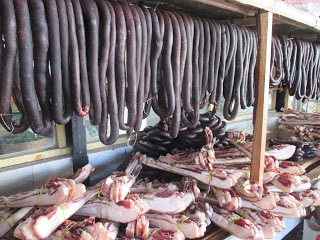 Their meat and fish selection however is not as varied nor as plentiful, but Mal finds a sniff delight in the sausage department and hankers after a slice of salami.
Their meat and fish selection however is not as varied nor as plentiful, but Mal finds a sniff delight in the sausage department and hankers after a slice of salami. Across the road and over a delightful timber and brick covered bridge – with the most gorgeous mandala on the ceiling – is the handicraft market which is full of thangkas, prayer wheels in every size, phalluses in every colour and surprisingly, crude ashtrays - very strange in a country where smoking is basically banned.
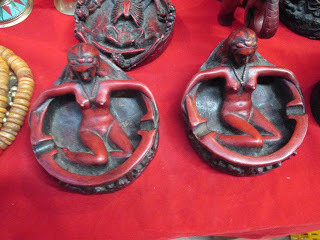

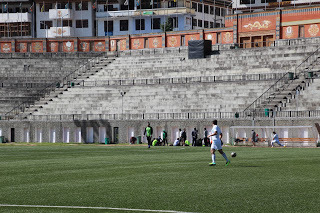 From the market we wander along the road past the very elaborate and manicured football stadium where we join a number of monks to peer through the closed barred gates and watch the national team practise. The monks are super excited. After a while of watching the team do warm up stretches and not much else, we leave and soon find ourselves at the National Archery Stadium of Changlinethang where a tournament is in place.
From the market we wander along the road past the very elaborate and manicured football stadium where we join a number of monks to peer through the closed barred gates and watch the national team practise. The monks are super excited. After a while of watching the team do warm up stretches and not much else, we leave and soon find ourselves at the National Archery Stadium of Changlinethang where a tournament is in place.  The archers are in full national dress (the Gho) with joggers, which although looks a little strange with long socks doesn’t at all reduce their elegant appearance – and it’s all very serious. We’re very close to the shooting line and clearly hear the swoosh and thud.
The archers are in full national dress (the Gho) with joggers, which although looks a little strange with long socks doesn’t at all reduce their elegant appearance – and it’s all very serious. We’re very close to the shooting line and clearly hear the swoosh and thud. 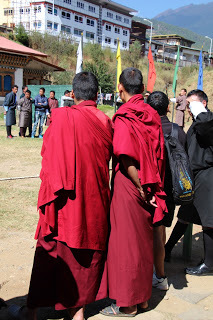 The thud is always followed by a rousing cheer and yell from down at the target end and from the shooters end the team encircles and begins a song and dance. I notice that amongst the crowd of keen onlookers, there’s only males; grown and child and many monks – they absolutely love the competition and watch with intense concentration – I’m the only woman in the audience. I ask our driver if women compete and he laughs and shakes his head, “No, this is for men only.” I tell him that back home women compete in all sports and we have very good archers. He looks amused.
The thud is always followed by a rousing cheer and yell from down at the target end and from the shooters end the team encircles and begins a song and dance. I notice that amongst the crowd of keen onlookers, there’s only males; grown and child and many monks – they absolutely love the competition and watch with intense concentration – I’m the only woman in the audience. I ask our driver if women compete and he laughs and shakes his head, “No, this is for men only.” I tell him that back home women compete in all sports and we have very good archers. He looks amused. As we leave the ground, we find ourselves amused by the notice warning about stray arrows, and wonder how many tyres get 'punctured'.

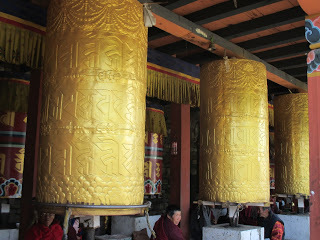
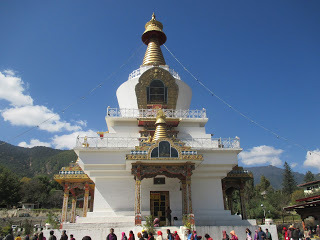 Just as we’re leading the archery our guide suggests we stop at the National Memorial Chorten, built in memory of the third king in 1974 and being the temple junkie I am I eagerly agree. It’s beautiful. A large white chorten with twelve enormous mani wheels near the front entrance, it sits on a large gardened round-a-bout and is well visited. Our guide tells us that many elderly people come here every day and spend most of their day here, chatting, meditating, and doing 108 circumambulations of the Chorten. We do three.
Just as we’re leading the archery our guide suggests we stop at the National Memorial Chorten, built in memory of the third king in 1974 and being the temple junkie I am I eagerly agree. It’s beautiful. A large white chorten with twelve enormous mani wheels near the front entrance, it sits on a large gardened round-a-bout and is well visited. Our guide tells us that many elderly people come here every day and spend most of their day here, chatting, meditating, and doing 108 circumambulations of the Chorten. We do three.
 From a beautiful peaceful memorial to a much loved king to an oversized enormous Buddha that I’m sure would confuse the original Buddha as to the true philosophy of his word. It screams ‘look at me’ and is all gold and glitz, so much so, it hurts the eyes to look at it in the stark midday sun. Gifted to Bhutan by Singapore we’re told that every piece of the building and its adornments were imported in from Singapore and costs a ridiculous amount. As we walk around it I can’t help wondering “Why”? and wouldn’t the money been better spent helping the Bhutanese improve their medical and education programmes. I find I’m becoming more perplexed about the contradiction of happiness and simpler life with the over the top ostentation and can’t see how gold leaf attached to a wall can bring happiness to a nation. I mention this to the guide and he smiles and says "It brings happiness to the people to see it." He then tells me that the 'third eye' is made up of precious stones - it all doesn't make sense to me. Up-close and inside the building is wall to wall gold, and houses 1000 small buddhas along with some beautiful artworks, including an intricate thangka made entirely of silk thread embroidery – the thangka is unbelievably stunning.
From a beautiful peaceful memorial to a much loved king to an oversized enormous Buddha that I’m sure would confuse the original Buddha as to the true philosophy of his word. It screams ‘look at me’ and is all gold and glitz, so much so, it hurts the eyes to look at it in the stark midday sun. Gifted to Bhutan by Singapore we’re told that every piece of the building and its adornments were imported in from Singapore and costs a ridiculous amount. As we walk around it I can’t help wondering “Why”? and wouldn’t the money been better spent helping the Bhutanese improve their medical and education programmes. I find I’m becoming more perplexed about the contradiction of happiness and simpler life with the over the top ostentation and can’t see how gold leaf attached to a wall can bring happiness to a nation. I mention this to the guide and he smiles and says "It brings happiness to the people to see it." He then tells me that the 'third eye' is made up of precious stones - it all doesn't make sense to me. Up-close and inside the building is wall to wall gold, and houses 1000 small buddhas along with some beautiful artworks, including an intricate thangka made entirely of silk thread embroidery – the thangka is unbelievably stunning.
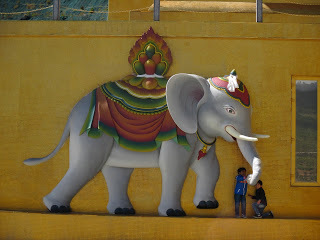
 Next to Buddha park, is a walking trail to a prayer-flagged festooned park that was opened in celebration of the marriage of the 5thKing. Holding a Guinness World Record for the most amount of trees – one thousand - planted at exactly the same time, Kuenselphodrang Nature Park is at a height of over 3000feet and has the most spectacular views of Thimphu city and the valley.
Next to Buddha park, is a walking trail to a prayer-flagged festooned park that was opened in celebration of the marriage of the 5thKing. Holding a Guinness World Record for the most amount of trees – one thousand - planted at exactly the same time, Kuenselphodrang Nature Park is at a height of over 3000feet and has the most spectacular views of Thimphu city and the valley.

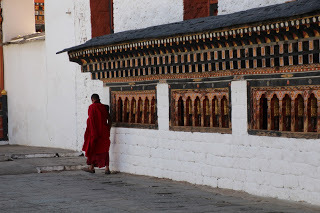 Spectacular however falls short for describing the Thimphu Dzong, our next stop. Surrounded by rose gardens, the Dzong is opposite the Royal Family’s palace and the National Parliament of Bhutan. We’re asked not to photograph the right side of the roadway as we walk up to the Dzong, as well as the first part of the Dzong as it is the administrative centre for not just the area but also the nation.
Spectacular however falls short for describing the Thimphu Dzong, our next stop. Surrounded by rose gardens, the Dzong is opposite the Royal Family’s palace and the National Parliament of Bhutan. We’re asked not to photograph the right side of the roadway as we walk up to the Dzong, as well as the first part of the Dzong as it is the administrative centre for not just the area but also the nation.There’s only a small part of the Dzong we can visit – the temple and the central courtyard – it’s a beautiful Dzong and what we are allowed to click away at shows nothing of its majesticness and beauty. The temple is incredibly beautiful and ornate and inside all I want to do is sit and while away some meditation time, but this is barely possible with the coming and goings of the tour groups. Plus our stomachs are grumbling – it’s lunch time, and as breakfast was nothing more than toast and tea, I’m eager for some real flavoursome food. We’ve noticed there is no such thing as morning tea on our ‘tour’ nor is there any chance to pop into a coffee shop for a pick-me-up caffeine shot.
Unfortunately lunch is again a buffet affair and consists of rice, noodles, butter fried vegies, fried potatoes and a stewed chicken dish. The only flavour on offer is good ol’ chili cheese as a side-dish. I’m mystified as to why we can’t choose our own restaurant or menu choices.
 After lunch we question our guide as to what dishes we will be learning to cook in our much anticipated class tonight. He tells us ‘chili cheese.’ ‘And?’ we ask. He looks perplexed, ‘just chili cheese,’ he replies. ‘Better not be just chili cheese.’ I retort, then I ask if it's possible to go to the restaurant and speak to the chef. We drive to a very swish looking restaurant that has a French-cum-vintage look to it, a beautiful restored Royal Enfield is displayed at the front and inside it has beautiful thick chunky timber tables and iron lace chairs. We’re introduced to the chef and with solemn apologies, he tells us we won’t be having a class tonight as he has a function to cater for. We stunned and wonder when this was (if it was) portrayed to our tour company or our guide. Back in the car we ask our guide what alternative might be made, he replies with, ‘That activity will no longer be happening.' I’m far from impressed. We ask to be taken back to town so we can have the rest of the afternoon to ourselves, and also suggest that because tonight’s class was cancelled, and as last night’s dinner was not very nice, we will find our own restaurant for this evenings meal. Our guide tells us we are not allowed to choose our own restaurant, he will organise it. And as we drive back to the centre of town he then tells us that we are going to the paper factory. My patience has become rice-paper thin.
After lunch we question our guide as to what dishes we will be learning to cook in our much anticipated class tonight. He tells us ‘chili cheese.’ ‘And?’ we ask. He looks perplexed, ‘just chili cheese,’ he replies. ‘Better not be just chili cheese.’ I retort, then I ask if it's possible to go to the restaurant and speak to the chef. We drive to a very swish looking restaurant that has a French-cum-vintage look to it, a beautiful restored Royal Enfield is displayed at the front and inside it has beautiful thick chunky timber tables and iron lace chairs. We’re introduced to the chef and with solemn apologies, he tells us we won’t be having a class tonight as he has a function to cater for. We stunned and wonder when this was (if it was) portrayed to our tour company or our guide. Back in the car we ask our guide what alternative might be made, he replies with, ‘That activity will no longer be happening.' I’m far from impressed. We ask to be taken back to town so we can have the rest of the afternoon to ourselves, and also suggest that because tonight’s class was cancelled, and as last night’s dinner was not very nice, we will find our own restaurant for this evenings meal. Our guide tells us we are not allowed to choose our own restaurant, he will organise it. And as we drive back to the centre of town he then tells us that we are going to the paper factory. My patience has become rice-paper thin.
 The paper factory tour does not eventuate and as we alight from the car we notice the air has cooled and it is late afternoon, the sun no longer lighting up the beautiful artwork on the centre of town - it's too late to get photos. Instead we spend the rest of the afternoon relaxing at Ambient Café and indulge in a coffee bean haze of joy. Later we wander down to the square and find a large screen in front of the clock tower and lots of excited locals eagerly waiting for a film on the Black Neck Crane to begin. It’s the National Conservation Film Festival, being held as part of the celebration lead-up for the Fourth Kings 60th birthday. We join the crowd until the cold gets too much for us then we scurry away to the restaurant that has been organised for our dinner. It’s an upmarket restaurant and we get all excited at the thought that it’ll be al-la-cart and eagerly await a menu – but no, it’s buffet. As we line up to help ourselves we begin chatting to one of the staff behind the counter and find she is the manager of the restaurant. Our conversation comes round to our cancelled cooking class and how disappointed we are and she tells us she owns a little homestay/lodge in Paro and offers cooking classes to her clients, and if we’d like, we are welcome to do a cooking class there when we return to Paro at the end of our tour.We are delighted and ask for a card to pass onto our tour company and guide. Then to our surprise she apologises for the lack of spicy flavour to the food serve at the restaurant and adds that she is 'embarrassed.' "But you will be delighted with the real taste of Bhutanese" she adds.
The paper factory tour does not eventuate and as we alight from the car we notice the air has cooled and it is late afternoon, the sun no longer lighting up the beautiful artwork on the centre of town - it's too late to get photos. Instead we spend the rest of the afternoon relaxing at Ambient Café and indulge in a coffee bean haze of joy. Later we wander down to the square and find a large screen in front of the clock tower and lots of excited locals eagerly waiting for a film on the Black Neck Crane to begin. It’s the National Conservation Film Festival, being held as part of the celebration lead-up for the Fourth Kings 60th birthday. We join the crowd until the cold gets too much for us then we scurry away to the restaurant that has been organised for our dinner. It’s an upmarket restaurant and we get all excited at the thought that it’ll be al-la-cart and eagerly await a menu – but no, it’s buffet. As we line up to help ourselves we begin chatting to one of the staff behind the counter and find she is the manager of the restaurant. Our conversation comes round to our cancelled cooking class and how disappointed we are and she tells us she owns a little homestay/lodge in Paro and offers cooking classes to her clients, and if we’d like, we are welcome to do a cooking class there when we return to Paro at the end of our tour.We are delighted and ask for a card to pass onto our tour company and guide. Then to our surprise she apologises for the lack of spicy flavour to the food serve at the restaurant and adds that she is 'embarrassed.' "But you will be delighted with the real taste of Bhutanese" she adds. 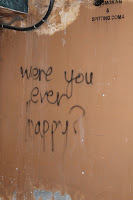 Just as we’re finishing our meal and readying to leave, the manager comes over to wish us a good journey and then tells us our guide has rung to check that we came to the restaurant for our meal. A feeling of being ‘watched’ comes over us. As we leave we pass a graffitied wall -“were you ever happy?” - the message whispers and I wonder - are they.
Just as we’re finishing our meal and readying to leave, the manager comes over to wish us a good journey and then tells us our guide has rung to check that we came to the restaurant for our meal. A feeling of being ‘watched’ comes over us. As we leave we pass a graffitied wall -“were you ever happy?” - the message whispers and I wonder - are they.
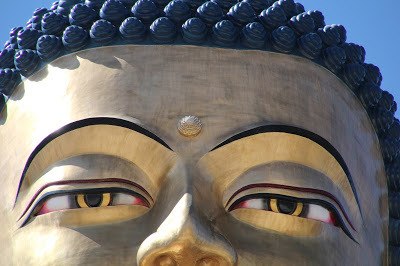
Published on November 18, 2015 06:47
November 15, 2015
Finding happiness along the Affirmation Highway

“Don’t hurry or your family will worry.” “Mountains are pleasure only if you drive at leisure.” “You must be the change you want to see in the world.”
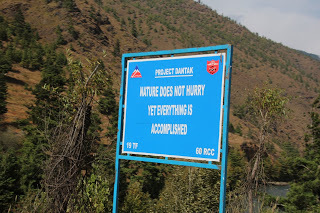
There’s no such thing as a roadside advertising billboard in Bhutan, and as we drive along the ‘affirmation highway’ - as I’ve dubbed the road from Haa to Thimphu - we are given gentle reminders to slow down and savour life. It’s not until we realise that the country side we are viewing is absent of the garish bombarding of commercialism and oversized advertising signs that it dawns on us how open and free the countryside feels and the views of quaint mud-rammed houses dotting rice terraces that cascade towards a wide aqua-green river gives us a feeling of serenity.
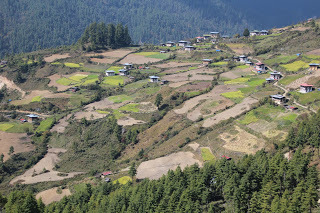 Although it's an ice-cold morning, we leave Haa in a blaze of sunshine, the heavily forested mountains glowing in a green and golden hue. The road hugs the side of the mountains, and we are awashed with views of chequered board fields in gold, red and green with villages of adorned white and timber houses. Far below, deeply plunging valleys fold into a coursing river that’s embroidered with rapids.
Although it's an ice-cold morning, we leave Haa in a blaze of sunshine, the heavily forested mountains glowing in a green and golden hue. The road hugs the side of the mountains, and we are awashed with views of chequered board fields in gold, red and green with villages of adorned white and timber houses. Far below, deeply plunging valleys fold into a coursing river that’s embroidered with rapids. 
 Every now and then we pass a chortan, a swathe of brightly flapping prayer flags or a long mani wall, the gold Sanskrit shining in the sunshine. The villages we passed through are idyllic, tiny winding laneways where the homes are beautifully decorated, as if each neighbour was trying to outdo the other.
Every now and then we pass a chortan, a swathe of brightly flapping prayer flags or a long mani wall, the gold Sanskrit shining in the sunshine. The villages we passed through are idyllic, tiny winding laneways where the homes are beautifully decorated, as if each neighbour was trying to outdo the other. 
Not only the windows, doors and walls painted and embellished, but so are the eves. At one village we stop and take a walk through – our car to meet us at the other side - the laneways laced in flowers, herbs and five leaf ‘mull’ plants that we’re told are only cattle feed – no wonder the cream coloured jerseys we see wandering around and lazily chewing their cuds have such sleepy doe-eyes.
 Just passed this village we view an enormous Dzong, once a jail for the worst of the worst and our guide tells us of how the prisoners were dealt with many years ago; tied into a sack and thrown down into the river, apparently if they survived the icy, turbulent waters, they could go free. It’s an impressive looking buildings perched high on a hill – indeed a room with an amazing view, but maybe one ‘you’ rather not see.
Just passed this village we view an enormous Dzong, once a jail for the worst of the worst and our guide tells us of how the prisoners were dealt with many years ago; tied into a sack and thrown down into the river, apparently if they survived the icy, turbulent waters, they could go free. It’s an impressive looking buildings perched high on a hill – indeed a room with an amazing view, but maybe one ‘you’ rather not see.
 Lunch time is approaching and our guide tells us we’ll be having lunch in a local home. We’re excited at the thought of being invited into a Bhutanese home and seeing how they live. We soon arrive at a small, but beautifully intricately decorated abode that’s still in the process of being built. Next door is a small restaurant. The home and the restaurant are sitting in the ‘middle of no-where’, not another house or village that we can see around. We jump out of the car and rustle through our packs for a couple of packets of macadamia nuts we’ve brought from home to give as gifts to our host. We’re introduced to a young woman, called Tenzin, and are taken around the back of the house and directed up a small ladder-cum-stairs to a room that doesn’t have any furniture, but is beautifully painted in swirls of orange on bright yellow, and adorned with photos of the royal family – I love it. We’re told to go into another room and here we find a small table and four chairs and a small cupboard in one corner. We take a seat, eager to chat. Tenzin smiles, gives a small bow then disappears from the room. Our guide opens a picnic basket and proceeds to unpack the meal, then tells us to help ourselves. We’re a little confused. “Is Tenzin not joining us.” We ask. “No, Tenzin has to serve in her restaurant” is the reply. We eat our lunch and drink our tea, just us and our guide and driver. Then it’s all packed up and we’re told it’s time to leave. Back downstairs we’re directed to get back in the car, but we say we’d like to go into the restaurant to thank Tenzin for the use of her home. Our guide is reluctant and tells us he has already thanked her. We insist on thanking her ourselves and go into the small, but cosy restaurant. It smells divine – the aromas drift around us and tantalise our tastebuds. We’re surprised to see how busy it is, every table filled with happy, hungry diners. We wonder where they’ve come from. We thank Tenzin then go back to the car, as I get in I ask our guide why we didn’t eat in the restaurant as it looked lovely. He gives me a concerned look and answers with ‘too dirty for tourists’. I’m shocked and assure him that it is far from that, but he shakes his head and tells us that tourists can’t possibly eat the food there, besides he adds, ‘it’s too spicy for you.’ I feel uncomfortable at how the expectations of tourists are perceived in Bhutan and wonder if it is just what our guide thinks or if this is the actual perception across the board.
Lunch time is approaching and our guide tells us we’ll be having lunch in a local home. We’re excited at the thought of being invited into a Bhutanese home and seeing how they live. We soon arrive at a small, but beautifully intricately decorated abode that’s still in the process of being built. Next door is a small restaurant. The home and the restaurant are sitting in the ‘middle of no-where’, not another house or village that we can see around. We jump out of the car and rustle through our packs for a couple of packets of macadamia nuts we’ve brought from home to give as gifts to our host. We’re introduced to a young woman, called Tenzin, and are taken around the back of the house and directed up a small ladder-cum-stairs to a room that doesn’t have any furniture, but is beautifully painted in swirls of orange on bright yellow, and adorned with photos of the royal family – I love it. We’re told to go into another room and here we find a small table and four chairs and a small cupboard in one corner. We take a seat, eager to chat. Tenzin smiles, gives a small bow then disappears from the room. Our guide opens a picnic basket and proceeds to unpack the meal, then tells us to help ourselves. We’re a little confused. “Is Tenzin not joining us.” We ask. “No, Tenzin has to serve in her restaurant” is the reply. We eat our lunch and drink our tea, just us and our guide and driver. Then it’s all packed up and we’re told it’s time to leave. Back downstairs we’re directed to get back in the car, but we say we’d like to go into the restaurant to thank Tenzin for the use of her home. Our guide is reluctant and tells us he has already thanked her. We insist on thanking her ourselves and go into the small, but cosy restaurant. It smells divine – the aromas drift around us and tantalise our tastebuds. We’re surprised to see how busy it is, every table filled with happy, hungry diners. We wonder where they’ve come from. We thank Tenzin then go back to the car, as I get in I ask our guide why we didn’t eat in the restaurant as it looked lovely. He gives me a concerned look and answers with ‘too dirty for tourists’. I’m shocked and assure him that it is far from that, but he shakes his head and tells us that tourists can’t possibly eat the food there, besides he adds, ‘it’s too spicy for you.’ I feel uncomfortable at how the expectations of tourists are perceived in Bhutan and wonder if it is just what our guide thinks or if this is the actual perception across the board.
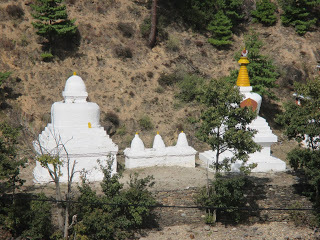 We continue on and soon reach the highway to Thimphu, passing over the river and past a set of beautiful chortens that glisten in the sunlight. The next hour ls spent reading affirmations and road safety messages dotted alongside the highway. Thimphu comes into view and unlike the delightful villages and small towns we’ve passed through, we find it to be a jungle of concrete buildings of various colours – all still decorated with the auspicious signs but no-where near as intricate or beautiful as the homes and shops of the smaller towns.
We continue on and soon reach the highway to Thimphu, passing over the river and past a set of beautiful chortens that glisten in the sunlight. The next hour ls spent reading affirmations and road safety messages dotted alongside the highway. Thimphu comes into view and unlike the delightful villages and small towns we’ve passed through, we find it to be a jungle of concrete buildings of various colours – all still decorated with the auspicious signs but no-where near as intricate or beautiful as the homes and shops of the smaller towns. 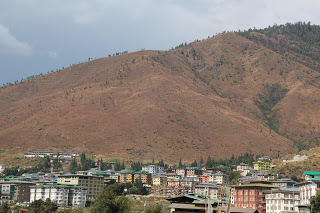 Thimphu is heavily congested with traffic and is noisy and dusty, but we’re keen to explore it, but our guide says first we must go to the Post Office where we can get a stamp with our photo on it. It sounds very kitsch to us and we say that we’re not really interested but apparently it’s a highlight on the tourist list and we are to do it. We drive into a building that looks as if it’s in need of a good renovation and we’re taken up a dark stairwell to a small room where a number of other tourists are gathered and being encourage to get their photos taken for a stamp. Again our guide suggest we too do this and again we decline. Instead we look at the stamps and first day issues and although I haven’t the least bit of interest in stamps, I buy a first-day-issue of the ‘strong man of Bhutan’, we do this because part way through our trip, our itinerary has us staying with the strongest man in Bhutan so I feel it’s only appropriate to have this little souvenir.
Thimphu is heavily congested with traffic and is noisy and dusty, but we’re keen to explore it, but our guide says first we must go to the Post Office where we can get a stamp with our photo on it. It sounds very kitsch to us and we say that we’re not really interested but apparently it’s a highlight on the tourist list and we are to do it. We drive into a building that looks as if it’s in need of a good renovation and we’re taken up a dark stairwell to a small room where a number of other tourists are gathered and being encourage to get their photos taken for a stamp. Again our guide suggest we too do this and again we decline. Instead we look at the stamps and first day issues and although I haven’t the least bit of interest in stamps, I buy a first-day-issue of the ‘strong man of Bhutan’, we do this because part way through our trip, our itinerary has us staying with the strongest man in Bhutan so I feel it’s only appropriate to have this little souvenir. 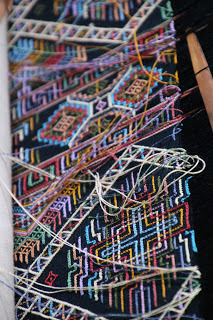 Our guide then tells us our next stop is a weaving centre but I suggest to him that we’d rather go to the Bhutan National Library to see the world’s largest book. Our guide insists we go to the weaving centre first, so off we go. The weaving centre is a small two storey building with the looms downstairs and a shop upstairs. We view the weaving – I’m astounded at how intricate the craftsmanship is and how these women work without a pattern. The pieces are incredibly vibrant and stunning. Then we are directed to the shop but I decline to purchase anything, being so early into our trip, I’m really not ready to commit to a weaving yet.
Our guide then tells us our next stop is a weaving centre but I suggest to him that we’d rather go to the Bhutan National Library to see the world’s largest book. Our guide insists we go to the weaving centre first, so off we go. The weaving centre is a small two storey building with the looms downstairs and a shop upstairs. We view the weaving – I’m astounded at how intricate the craftsmanship is and how these women work without a pattern. The pieces are incredibly vibrant and stunning. Then we are directed to the shop but I decline to purchase anything, being so early into our trip, I’m really not ready to commit to a weaving yet.  I ask again if we can go to the Library but instead we are taken to an art gallery where the most beautiful thangkas and Bhutanese landscapes adorn the walls, once again it is suggested – ever so subtle - for us to purchase a little piece.
I ask again if we can go to the Library but instead we are taken to an art gallery where the most beautiful thangkas and Bhutanese landscapes adorn the walls, once again it is suggested – ever so subtle - for us to purchase a little piece. We are then told we are going to go to a paper-making factory, but I say I’d like to be to be taken to the Library and, we’re told it’s now near closing time so it’ll be a quick visit. I’m far from impressed when told this.
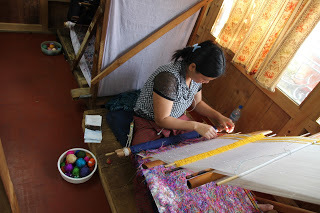
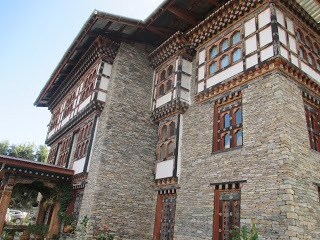 Bhutan’s National Library is gorgeous. A stunning piece of architecture surrounded by the most beautiful rose gardens and with an even more stunning outlook. Inside the library itself is a beautiful piece of art – wide timber floors, worn smooth with time, intricately painted shelves and architraves, and rows upon rows of Buddhists texts in various colours behind glass, some of them hundreds of years old. We’re taken first to a room to see a smaller version of the ‘world’s biggest book’, which is a pictorial display of Bhutan’s landscapes and culture, then we go to the main room to view the real book. It’s huge and kept in a massive glass case. The page is open to an image of mountains with prayer flags. Photography is not allowed in the library but this doesn’t deter many of the tourists who sneak a snap on their smart-phones. As we leave the library, our guide suggests we now visit the paper-factory but all we want to do is put our bags in the hotel and go find a much need cup of coffee – preferably of the roasted beans variety. Once again the hotel we are staying at is well out of town – it’s big and impersonal and when we enter our room we’re dismayed to see that it quite run-down. We’re here for two nights. We quickly stash the bags and get the driver (and guide) to take us into Thimphu central so we can start exploring the capital city of Bhutan…and of course find that coffee.
Bhutan’s National Library is gorgeous. A stunning piece of architecture surrounded by the most beautiful rose gardens and with an even more stunning outlook. Inside the library itself is a beautiful piece of art – wide timber floors, worn smooth with time, intricately painted shelves and architraves, and rows upon rows of Buddhists texts in various colours behind glass, some of them hundreds of years old. We’re taken first to a room to see a smaller version of the ‘world’s biggest book’, which is a pictorial display of Bhutan’s landscapes and culture, then we go to the main room to view the real book. It’s huge and kept in a massive glass case. The page is open to an image of mountains with prayer flags. Photography is not allowed in the library but this doesn’t deter many of the tourists who sneak a snap on their smart-phones. As we leave the library, our guide suggests we now visit the paper-factory but all we want to do is put our bags in the hotel and go find a much need cup of coffee – preferably of the roasted beans variety. Once again the hotel we are staying at is well out of town – it’s big and impersonal and when we enter our room we’re dismayed to see that it quite run-down. We’re here for two nights. We quickly stash the bags and get the driver (and guide) to take us into Thimphu central so we can start exploring the capital city of Bhutan…and of course find that coffee. 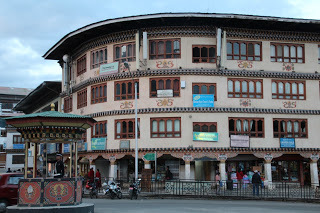 And again the guide is reluctant to let us go by ourselves, and tells us that Thimphu can be unsafe and that the traffic is bad, but we insist on being allowed to wander and look by ourselves. We are finally dropped off near the “Times Square” of Thimphu a square with prayer wheel walls and a clock tower in the centre, and we go in search of coffee, finding it in a delightful café called ‘Ambient’ – it’s perfect! The coffee just as good as home, the atmosphere fantastic and the Wi-Fi fast. We spend a good two hours whiling away the late afternoon, then enjoy shuffling about in Thimphu’s vibrant main street, a collection of old-style timber shops with low doors and modern glass and chrome flash. As the evening starts to fall the city becomes more bustling and the smells of Bhutanese flavours wafts out of small cafes and restaurants. We’ve been told that dinner begins at seven at our hotel, so we catch a taxi back. We are to find we should have stayed in the main street and found a dinner there, for the hotel fare is exceeding dismal. Once again the delectable ‘taste’ of Bhutan remains nothing more than an aromaous sniff.
And again the guide is reluctant to let us go by ourselves, and tells us that Thimphu can be unsafe and that the traffic is bad, but we insist on being allowed to wander and look by ourselves. We are finally dropped off near the “Times Square” of Thimphu a square with prayer wheel walls and a clock tower in the centre, and we go in search of coffee, finding it in a delightful café called ‘Ambient’ – it’s perfect! The coffee just as good as home, the atmosphere fantastic and the Wi-Fi fast. We spend a good two hours whiling away the late afternoon, then enjoy shuffling about in Thimphu’s vibrant main street, a collection of old-style timber shops with low doors and modern glass and chrome flash. As the evening starts to fall the city becomes more bustling and the smells of Bhutanese flavours wafts out of small cafes and restaurants. We’ve been told that dinner begins at seven at our hotel, so we catch a taxi back. We are to find we should have stayed in the main street and found a dinner there, for the hotel fare is exceeding dismal. Once again the delectable ‘taste’ of Bhutan remains nothing more than an aromaous sniff.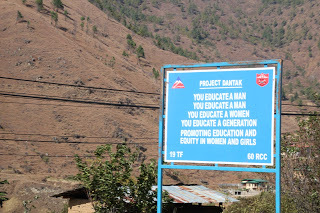

Published on November 15, 2015 03:26
November 11, 2015
Bless you at the Haa Chu

 “I think they should rename this place The Chilly Pass,” I say to Mal as I stand huddled next to a clay stove and try to garner some warmth. Me along with ten others – all Indian nationals – try to find the best spot next to the fire. In front we stare at the most incredible view, upright white flags on a forest of poles snaking along a ridge line to a peak, flutter against blue skies. Either side, deep plunging green valleys spiral into dark voids and all around a kaleidoscopic swirl of colour flaps and strains and whips in the wind – prayer flags for as far as the eye can see. We are at the top of Bhutans highest motorable pass – the Chele La at (officially 3,780meters, although the sign I’m standing next to says 3988meters and our vehicles altitude reader is spruking 4030meters. Whichever it is, it’s high! And I’m starting to feel some affects of altitude. A throbbing headache and a bit of a dizz, although, I think that might be from the hairpin corners.
“I think they should rename this place The Chilly Pass,” I say to Mal as I stand huddled next to a clay stove and try to garner some warmth. Me along with ten others – all Indian nationals – try to find the best spot next to the fire. In front we stare at the most incredible view, upright white flags on a forest of poles snaking along a ridge line to a peak, flutter against blue skies. Either side, deep plunging green valleys spiral into dark voids and all around a kaleidoscopic swirl of colour flaps and strains and whips in the wind – prayer flags for as far as the eye can see. We are at the top of Bhutans highest motorable pass – the Chele La at (officially 3,780meters, although the sign I’m standing next to says 3988meters and our vehicles altitude reader is spruking 4030meters. Whichever it is, it’s high! And I’m starting to feel some affects of altitude. A throbbing headache and a bit of a dizz, although, I think that might be from the hairpin corners.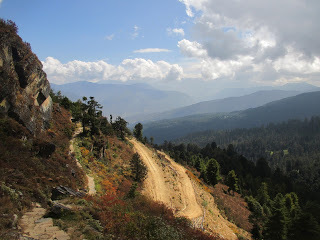
It was an early rise as we were in for a big day – leaving Paro to visit the Haa Valley. It was super early for me though, up a three am, the body clock was way out of sync and the head throb had also started. I’d been warned that it might happen at Paro but was assured by the guide that we were just under the level where altitude sickness happens and that if we took it easy we’d acclimatize. I took his advice and threw down a couple of headache tablets, skipped my morning coffee and took it easy. Not that there was going to be too much activity – our hotel was well and truly out of town and surrounded by dogs wandering around the roads, so a little stroll to check out the early morning local life wasn’t on the cards and at the hotel, we weren’t being allowed to lift a finger. Even pouring our own milk into a cup of tea was a no-no. We were to be waited on hand and foot. I wondered if I could ‘get use to this’ then decided no - I’d be drinking too much hot milk. (I’m to find Tea here is more milk than brew and weak is an understatement!)
 Our guide and driver collected us bright and early and we were zipped along past rice fields and up into the mountains. It was a long drive, winding and pot-holed but stunningly spectacular with views that went forever. Every now and then we would drive under a swathe of prayerflags and past enormous Mani Wheels that spun at incredible speeds, throwing out their blessings, as they were operated by small waterfalls and fast flowing streams. Part way up we turned off the bitumen road and bounced along a rough rocky track to a nunnery – the Kila Goempa – where we’re told about 100 nuns (young and old) lived in isolation. We’re also told that they rarely got visitors, a statement we find a little strange, because when we arrive there are a number of tourist cars and a bus sitting in the car park, and a number of tourists hiking along the narrow track that clings to the side of a steep cliff. We join the trail of visitors and wander along the narrow path for about 150meters. Actually it was barely a wander for being so high, the air is clean, crisp and thin and we both feel the shortness of breath - so much so, we huff and puff as we walk along and I tell Mal we need to be careful that we don’t blow the precariously clinging abodes away.
Our guide and driver collected us bright and early and we were zipped along past rice fields and up into the mountains. It was a long drive, winding and pot-holed but stunningly spectacular with views that went forever. Every now and then we would drive under a swathe of prayerflags and past enormous Mani Wheels that spun at incredible speeds, throwing out their blessings, as they were operated by small waterfalls and fast flowing streams. Part way up we turned off the bitumen road and bounced along a rough rocky track to a nunnery – the Kila Goempa – where we’re told about 100 nuns (young and old) lived in isolation. We’re also told that they rarely got visitors, a statement we find a little strange, because when we arrive there are a number of tourist cars and a bus sitting in the car park, and a number of tourists hiking along the narrow track that clings to the side of a steep cliff. We join the trail of visitors and wander along the narrow path for about 150meters. Actually it was barely a wander for being so high, the air is clean, crisp and thin and we both feel the shortness of breath - so much so, we huff and puff as we walk along and I tell Mal we need to be careful that we don’t blow the precariously clinging abodes away.
 The nunnery hugs the sheer cliff face and every view is spectacular. It’s the most perfect place to meditate and contemplate the meaning of life and existence, though I think for me, I’d spend more time bird watching than inner thinking. The birds are abundant, as are the flowers that cover the path. The temples and small abodes that make up the nunnery are very simple – white, rustic and lightly decorated in the traditional artwork, yet the whole place is idyllic and beautiful. We’re taken right up to where the nuns, of all ages, are sitting and chatting, a couple of them are trying to blow very large trumpets, and we’re told we can ‘take their photos’.
The nunnery hugs the sheer cliff face and every view is spectacular. It’s the most perfect place to meditate and contemplate the meaning of life and existence, though I think for me, I’d spend more time bird watching than inner thinking. The birds are abundant, as are the flowers that cover the path. The temples and small abodes that make up the nunnery are very simple – white, rustic and lightly decorated in the traditional artwork, yet the whole place is idyllic and beautiful. We’re taken right up to where the nuns, of all ages, are sitting and chatting, a couple of them are trying to blow very large trumpets, and we’re told we can ‘take their photos’.  I find this an uncomfortable proposition and decline. I also feel like we have intruded upon their self-imposed seclusion and a sense of voyeuristic guilt drapes over me. We thank them for letting us visit their home and our guide takes us to the small main temple which is stunningly intricate inside with its artworks and icons. Now this I wish I could photograph, but photography in the temples is not allowed and is strictly monitored.
I find this an uncomfortable proposition and decline. I also feel like we have intruded upon their self-imposed seclusion and a sense of voyeuristic guilt drapes over me. We thank them for letting us visit their home and our guide takes us to the small main temple which is stunningly intricate inside with its artworks and icons. Now this I wish I could photograph, but photography in the temples is not allowed and is strictly monitored.
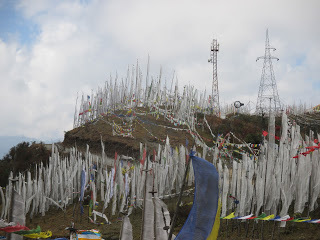 From the nunnery we head up another 5oo meters to the Chele La (La means pass in Bhutanese). While we’re there our driver shares with me that the pass is extra special for him as two of the white flags standing on the peak are his offerings for a passed sister. He explains to me that the white flags represent remembrance of lost loved ones for Bhutan doesn’t have grave yards. After cremation, the ashes are scattered, and a white flag becomes their marker.After the obligatory photos and hug of the fire, we jump back in the car and head down again. Just before we hop in the car, we meet up with two women on Royal Enfield motorcycles who are traveling the length of Bhutan. They cause quite a stir with a large group of Indian Nationals who have come to Bhutan for their Puja holidays and they line up to have their photos taken with them. There’s lots of laughter and giggles, and I’m quite impressed with the women and their bravery to ride Bhutan’s roads on such ‘ancient’ looking motorcycles. In fact, I wish I had their tenacity and bravery.
From the nunnery we head up another 5oo meters to the Chele La (La means pass in Bhutanese). While we’re there our driver shares with me that the pass is extra special for him as two of the white flags standing on the peak are his offerings for a passed sister. He explains to me that the white flags represent remembrance of lost loved ones for Bhutan doesn’t have grave yards. After cremation, the ashes are scattered, and a white flag becomes their marker.After the obligatory photos and hug of the fire, we jump back in the car and head down again. Just before we hop in the car, we meet up with two women on Royal Enfield motorcycles who are traveling the length of Bhutan. They cause quite a stir with a large group of Indian Nationals who have come to Bhutan for their Puja holidays and they line up to have their photos taken with them. There’s lots of laughter and giggles, and I’m quite impressed with the women and their bravery to ride Bhutan’s roads on such ‘ancient’ looking motorcycles. In fact, I wish I had their tenacity and bravery.
 We leave the pass and stop further down the road for a picnic. We are to find the Bhutanese love their picnics – it’s a national pastime, to take a packed lunch in tiffin tins and spread out in a meadow, beside the road amongst the hills or near a raging river. I love it! We choose a meadow near a cow shed and enjoy a smashing meal of red rice, curry and an amazing potato dish that I just want to learn to create. And of course the must have – chili cheese.
We leave the pass and stop further down the road for a picnic. We are to find the Bhutanese love their picnics – it’s a national pastime, to take a packed lunch in tiffin tins and spread out in a meadow, beside the road amongst the hills or near a raging river. I love it! We choose a meadow near a cow shed and enjoy a smashing meal of red rice, curry and an amazing potato dish that I just want to learn to create. And of course the must have – chili cheese.
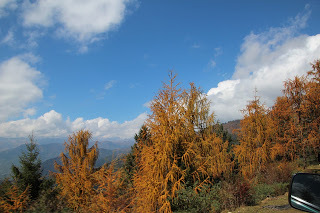 Zipping down the mountain the scenery changes from green to golden as we come across a grove of beautiful turned fir trees and maples. Splashes of colour race up to meet us as we weaved through the hairpins. Part way down we pass emergency vehicles – a tiny ambulance and two small cars filled with personnel in orange-overalls. “Accident” comments our guide and we keep going.
Zipping down the mountain the scenery changes from green to golden as we come across a grove of beautiful turned fir trees and maples. Splashes of colour race up to meet us as we weaved through the hairpins. Part way down we pass emergency vehicles – a tiny ambulance and two small cars filled with personnel in orange-overalls. “Accident” comments our guide and we keep going.
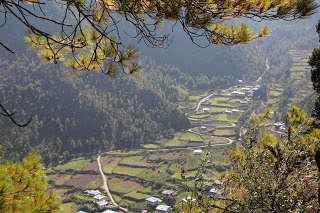 The Haa valley is wide and green with a huge river running through the middle. Rice fields and cattle dot the landscape. We pass a golf course and helicopter pad and our guide points out some army barracks – ‘Indian Army’ he says, ‘they protect us.’ Our first stop is to a Temple from the 7th century, we're not sure if it's the Black Temple or the White, but it has brand new buildings being erected around it and it’s interesting to see how they form the structures which will be painted just like all the other buildings in Bhutan with the traditional ornate features.
The Haa valley is wide and green with a huge river running through the middle. Rice fields and cattle dot the landscape. We pass a golf course and helicopter pad and our guide points out some army barracks – ‘Indian Army’ he says, ‘they protect us.’ Our first stop is to a Temple from the 7th century, we're not sure if it's the Black Temple or the White, but it has brand new buildings being erected around it and it’s interesting to see how they form the structures which will be painted just like all the other buildings in Bhutan with the traditional ornate features. 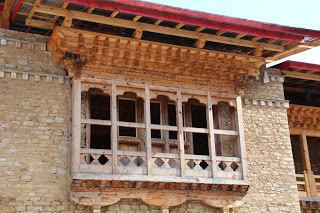 We enter the temple and ooh and arh over the glorious artwork, the colours still vibrant and lush after years of being. While there we meet up with a fellow traveller who had also been staying at the same hotel the night before. He tells us that a dreadful accident happened at Chele La, a bus that was reversing plummeted over one of the cliffs, it had five Indian Nationals on it – the rest of the group were still waiting to board, at least one had died. It dawns on us it was the same group who were at the pass the same time as us, the ones who were having their photos taken with the two motorcycle women. We are devastated for them and their family.We leave the temple with sadness and go to our hotel. Again it is outside of the town, and again the area is surrounded by numerous wandering dogs. After dropping our bags to our room (and Mal has the standard luggage tug-a-war with the baggage girls - they win), we ask our guide to take us to the town so we can explore. He’s a little hesitate, telling us there’s not much to see in Haa, but we say we’d like to see it anyway. Our driver takes us to the other side of the township so we can have a good walk through, and as we’re being dropped off we find ourselves having a bit of a ‘run-in’ with two cows. Well not quite so much as a run in as a run away. Just as I close the car door, two cows with nice little sharp horns, decide to have a tussle with each other, locking horns they push at each other and end up stumbling towards us. I run towards the front of the car and almost get myself run over as our driver, realising the cows are heading for his car, launches the car forward then has to hit the brakes as I tap the front bumper. This in turns results in the cows crashing into the side of the car and the horns make an enormous scrape mark up the side of the car. Our driver is most upset - it turns out he doesn't own the car and vehicles in Bhutan are an expensive luxury few Bhutanese can afford. We feel dreadful for him.
We enter the temple and ooh and arh over the glorious artwork, the colours still vibrant and lush after years of being. While there we meet up with a fellow traveller who had also been staying at the same hotel the night before. He tells us that a dreadful accident happened at Chele La, a bus that was reversing plummeted over one of the cliffs, it had five Indian Nationals on it – the rest of the group were still waiting to board, at least one had died. It dawns on us it was the same group who were at the pass the same time as us, the ones who were having their photos taken with the two motorcycle women. We are devastated for them and their family.We leave the temple with sadness and go to our hotel. Again it is outside of the town, and again the area is surrounded by numerous wandering dogs. After dropping our bags to our room (and Mal has the standard luggage tug-a-war with the baggage girls - they win), we ask our guide to take us to the town so we can explore. He’s a little hesitate, telling us there’s not much to see in Haa, but we say we’d like to see it anyway. Our driver takes us to the other side of the township so we can have a good walk through, and as we’re being dropped off we find ourselves having a bit of a ‘run-in’ with two cows. Well not quite so much as a run in as a run away. Just as I close the car door, two cows with nice little sharp horns, decide to have a tussle with each other, locking horns they push at each other and end up stumbling towards us. I run towards the front of the car and almost get myself run over as our driver, realising the cows are heading for his car, launches the car forward then has to hit the brakes as I tap the front bumper. This in turns results in the cows crashing into the side of the car and the horns make an enormous scrape mark up the side of the car. Our driver is most upset - it turns out he doesn't own the car and vehicles in Bhutan are an expensive luxury few Bhutanese can afford. We feel dreadful for him.
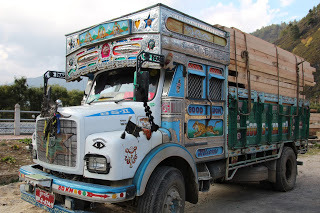 From horn wielding cows, we find we have to run the gauntlet of street dogs when a pack of them realise someone new has entered their territory and come tearing towards us. Thankfully, some of the locals come out and chase them away. They give us cheery smiles and wave us on our way through their village. It’s very rural, lots of small timber huts with hay stacks around, their homes however all sport the beautiful artworks of the twelve auspicious signs and dancing phalluses. Prayer flags hang on the bridges and along fence lines and we pass goods carrying trucks that also look like works of art with their decorated cabins and images of deities and good luck wishes.
From horn wielding cows, we find we have to run the gauntlet of street dogs when a pack of them realise someone new has entered their territory and come tearing towards us. Thankfully, some of the locals come out and chase them away. They give us cheery smiles and wave us on our way through their village. It’s very rural, lots of small timber huts with hay stacks around, their homes however all sport the beautiful artworks of the twelve auspicious signs and dancing phalluses. Prayer flags hang on the bridges and along fence lines and we pass goods carrying trucks that also look like works of art with their decorated cabins and images of deities and good luck wishes.
 The air starts to cool as we enter the main street of the village and we pass the everyday shops that sell packets of chips, bottled water and dried chilies, nestled in with karaoke bars and government offices. Our driver and guide are waiting for us and as we cross over a small swing bridge spanning the Haa Chu we are blanketed in a flap of prayer flags. Never one to miss a word play, Mal pipes up with "Bless You". I certainly do feel incredibly blessed.
The air starts to cool as we enter the main street of the village and we pass the everyday shops that sell packets of chips, bottled water and dried chilies, nestled in with karaoke bars and government offices. Our driver and guide are waiting for us and as we cross over a small swing bridge spanning the Haa Chu we are blanketed in a flap of prayer flags. Never one to miss a word play, Mal pipes up with "Bless You". I certainly do feel incredibly blessed.
Published on November 11, 2015 13:30
November 9, 2015
Discovering the land of the Thunder Dragon. Bhutan

“What instrument do you measure Gross National Happiness with?” we’re asked, ten minutes into our ride from the airport. I contemplate this question for a moment, trying to think of a profound and wise reply but Mal comes back quickly with “Why by the size of the smile on your dial. The bigger the smile the more happiness buck you’ve got in the soul bank”. “Then I hope you will feel like a wealthy man after leaving Bhutan” comes back the reply.

If smiles are anything to go by there was certainly a lot of deposits being made. The moment we entered the embarkation hall in Tribhuvan Airport at Nepal in readiness to board our DrukAir flight, the smiles were wide and the atmosphere filled with eager chattering and laughing. It was as if we were all about to head off on a big school excursion, the excitement palpable. We all knew we were going to the same place, possibly see the same things and most probably, bump into each other along the way. People were introducing themselves and asking ‘which tour company’ and ‘when are you hiking Tigers Nest’.
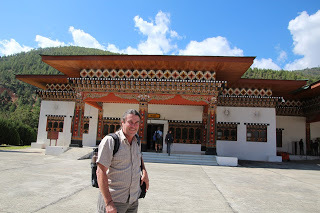 It would have to have been one of the few flights I’ve ever taken where everyone is happy and chatty and when it was time to disembark we’re all blissfully waiting our turn to file up the aisle with not a single huff and puff in sight. Not even when we realised we all had to wait for the VIP that was on our plane to be given a red-carpet roll out and all the staff of the airport ran onto the tarmac for form a guard of honour.
It would have to have been one of the few flights I’ve ever taken where everyone is happy and chatty and when it was time to disembark we’re all blissfully waiting our turn to file up the aisle with not a single huff and puff in sight. Not even when we realised we all had to wait for the VIP that was on our plane to be given a red-carpet roll out and all the staff of the airport ran onto the tarmac for form a guard of honour. 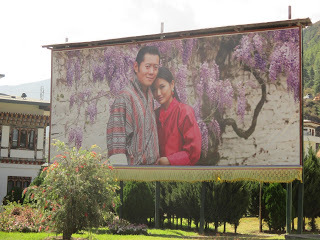 Once off the plane we are greeted by the prettiest airport embellished in beautiful decorative artwork and large billboard sign displaying a most handsome couple – the fifth king of Bhutan – Jigme Khesar Namgyel Wangchuck and his beautiful queen – Jetsun Pema . Cameras are whipped out and people start wandering around the tarmac posing beside the plane, the terminal, and in front of the billboard. There’s a feeling was of complete cheerfulness and unlike other airports where security is at a premium and any sign of a camera brings scowls and reprimands, not so at Paro International Airport. Inside passengers are in awe of the decorative ceiling and continue clicking away at the mandala that takes centre stage. By time we’ve get to baggage collection many of us have introduced ourselves, compare itineraries and depart with a ‘might see you around at one of the towns’.
Once off the plane we are greeted by the prettiest airport embellished in beautiful decorative artwork and large billboard sign displaying a most handsome couple – the fifth king of Bhutan – Jigme Khesar Namgyel Wangchuck and his beautiful queen – Jetsun Pema . Cameras are whipped out and people start wandering around the tarmac posing beside the plane, the terminal, and in front of the billboard. There’s a feeling was of complete cheerfulness and unlike other airports where security is at a premium and any sign of a camera brings scowls and reprimands, not so at Paro International Airport. Inside passengers are in awe of the decorative ceiling and continue clicking away at the mandala that takes centre stage. By time we’ve get to baggage collection many of us have introduced ourselves, compare itineraries and depart with a ‘might see you around at one of the towns’. 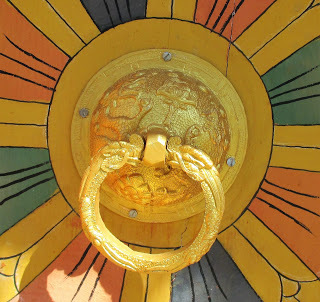
Outside the front door of the airport everyone is gathered up by their guide and driver. There’s not a taxi tout in sight – just lots of men dressed in Ghos (the National dress for men in Bhutan) and wide smiles. Straight away we see our names on a placard held by a man in his thirties – he has dark hair, beautiful twinkling eyes and beaming smile – our guide. Next to him stands our driver, of equal age, but he has a quiet contemplative look about him. They both look extremely distinguished in their sharply pressed-not-a-wrinkle-in-sight Ghos.
For a split second I get a slight panic feeling as I think, oh my I hope these guys are nice, we’re about to spend nearly every minute of the next 17days with each other – I hope we’re friends at the end of it.
Our first night in Bhutan will be spent in Paro itself, about a half-hour drive from the airport and yet it’s almost next door to the town. The reason it takes so long is we have to traverse the full length of the airport landmass – twice. Once up one side of the runway, over a river and then back the full length only the road runs out at one section and we enter a ‘paddock’ with a bumpy track which we need to crawl along.
“Free massage” quips our guide.
 Just past the airport we stop for our very first sight - a magnificent white building on the side of a cliff. Below it, the sweetest little covered bridge and above it sits another white and redbrick structure, also clinging to the cliff – the watchtower. This is the Paro Dzong, also known as Rinchen Pung Dzong. A fortress that was first built around 1644 and over the years has survived earthquakes and fires to rise many times over. Our guide tells us we’ll be exploring this in the afternoon and leads us across the road to a grassy park-like area where archery practice is taking place. He directs us to almost centre of the firing line and tells us to take a seat. “What in front of the archers” I exclaim. “Don’t worry madam, they are professionals.” An arrow wizzes past and thuds into the small target that’s been ‘stabbed’ into the ground.I look at the tree next to me – there are perfectly round holes in its trunk.
Just past the airport we stop for our very first sight - a magnificent white building on the side of a cliff. Below it, the sweetest little covered bridge and above it sits another white and redbrick structure, also clinging to the cliff – the watchtower. This is the Paro Dzong, also known as Rinchen Pung Dzong. A fortress that was first built around 1644 and over the years has survived earthquakes and fires to rise many times over. Our guide tells us we’ll be exploring this in the afternoon and leads us across the road to a grassy park-like area where archery practice is taking place. He directs us to almost centre of the firing line and tells us to take a seat. “What in front of the archers” I exclaim. “Don’t worry madam, they are professionals.” An arrow wizzes past and thuds into the small target that’s been ‘stabbed’ into the ground.I look at the tree next to me – there are perfectly round holes in its trunk.
We’re zipped through the main street of Paro – ‘old town’ – a quaint little town full of building adorned in glorious art and colour and my eyes widen when I notice that many of the drawings are of large than life penises, and out again, heading towards forested mountains and chequer-board farmlands till we soon arrive at our hotel cum resort. We will notice that nearly every hotel/guest house has the word resort in their name…but they nothing like the standard resorts found in other Asian countries. These are quaint little hotels with gorgeous gardens and lots of stone steps. There won’t be a pool in sight nor a cocktail bar… and definitely no kids club.
Within seconds of arriving at the resort two petite women appear, wearing long skirts and beautiful silk blouses and they have our twenty kilo backpacks out of the car and are carrying them up the steps to the lobby. We protest but they ignore us and shuffle away, Mal runs after them and tries to take the bag off one – there’s a little tug-a-war. The woman wins.
 Our room is amazing and the view spectacular but we are given no time to ooh and arh and we’re whisked away for lunch – our first taste of Bhutanese food. Our taste buds are salivating.Our tastebuds are salivating. We're to eat back in Paro and are led to back streets where every building is beautifully decorated and windows hand with chili drapes. Up a set of old and somewhat dark steps, we enter into a room that is as exquisitely painted inside as out and we sit down, excitedly await for the menu. It doesn't arrive. Instead our table is laden with various dishes - rice, noodles, broccoli, cabbage, fried chicken and momos. We stare at it and feel a slight touch of dismay. Other than the momos, it all looks very western - and very plain. We wonder, where's the spice, where's the flavour we've heard so much about. I scoop up rice and vegertables onto my plate and am just about to lift my first fork full into my mouth when a cockroach crawls out of the rice. Oh dear... it's not a good start. But all is quickly forgotten an hour later when we head for the "Fortress on a Heap of Jewels" - the Paro Dzong.
Our room is amazing and the view spectacular but we are given no time to ooh and arh and we’re whisked away for lunch – our first taste of Bhutanese food. Our taste buds are salivating.Our tastebuds are salivating. We're to eat back in Paro and are led to back streets where every building is beautifully decorated and windows hand with chili drapes. Up a set of old and somewhat dark steps, we enter into a room that is as exquisitely painted inside as out and we sit down, excitedly await for the menu. It doesn't arrive. Instead our table is laden with various dishes - rice, noodles, broccoli, cabbage, fried chicken and momos. We stare at it and feel a slight touch of dismay. Other than the momos, it all looks very western - and very plain. We wonder, where's the spice, where's the flavour we've heard so much about. I scoop up rice and vegertables onto my plate and am just about to lift my first fork full into my mouth when a cockroach crawls out of the rice. Oh dear... it's not a good start. But all is quickly forgotten an hour later when we head for the "Fortress on a Heap of Jewels" - the Paro Dzong.
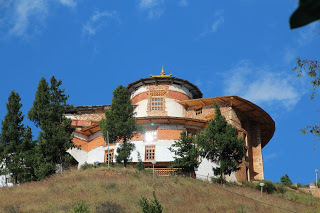 Our guide takes us first to the old watchtower, which was until three years ago the National Museum, but was damaged in the 2011 earthquake. The museum is now in an impressive building just behind the tower. Here we see the incredible masks of the Tsechus (festivals) that Bhutan is famous for and age-old stunning thangkas – some hundreds of years old; their colours still vibrant.
Our guide takes us first to the old watchtower, which was until three years ago the National Museum, but was damaged in the 2011 earthquake. The museum is now in an impressive building just behind the tower. Here we see the incredible masks of the Tsechus (festivals) that Bhutan is famous for and age-old stunning thangkas – some hundreds of years old; their colours still vibrant. 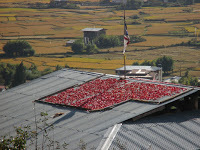 Downhill, past farm homes with chilli’s spread across their rooves to dry – ‘a hot tin roof’ quips Mal - we hike to the massive fortress, the Dzong. Before going in our guide puts a cream colour scarf across his Gho – it is required that all visitors to Dzongs be attired in formal wear – and this includes tourists – women must have long sleeves and men to wear collared shirts. The Dzong is incredible. We walk up a huge flank of steps past two enormous doors and into a darken corridor adorned in stunning buddhist art – wheel of life, images of Guru Rinpoche and the four friends.
Downhill, past farm homes with chilli’s spread across their rooves to dry – ‘a hot tin roof’ quips Mal - we hike to the massive fortress, the Dzong. Before going in our guide puts a cream colour scarf across his Gho – it is required that all visitors to Dzongs be attired in formal wear – and this includes tourists – women must have long sleeves and men to wear collared shirts. The Dzong is incredible. We walk up a huge flank of steps past two enormous doors and into a darken corridor adorned in stunning buddhist art – wheel of life, images of Guru Rinpoche and the four friends.
 From the corridor we step out into a stunning courtyard with a temple in the middle. Our guide tells us that Dzongs house both a monastic community and administration services for the area and some have courts. We don’t know where to look first, the art work and majesticness of the Dzong has us spellbound. One thing we must remember is to always walk clockwise around anything. There are prayer wheels everywhere to and each time we past one we give it a spin, sending out endless prayers to the universe. The Dzong sits on the edge of a cliff and has the most commanding views of the Paro valley and river below – the Pho Chuu.
From the corridor we step out into a stunning courtyard with a temple in the middle. Our guide tells us that Dzongs house both a monastic community and administration services for the area and some have courts. We don’t know where to look first, the art work and majesticness of the Dzong has us spellbound. One thing we must remember is to always walk clockwise around anything. There are prayer wheels everywhere to and each time we past one we give it a spin, sending out endless prayers to the universe. The Dzong sits on the edge of a cliff and has the most commanding views of the Paro valley and river below – the Pho Chuu.
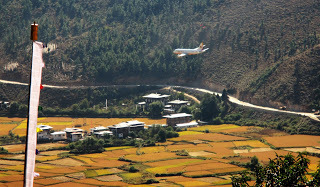
As we stare down at it, the DrukAir flight leaving the Paro Airport flies past. After hours of being mesmerised by the beautiful artwork of the Dzong and its temple, we then trek down a wooded path to the quaint timber and rammed earth covered bridge that crosses the Pho Chuu. It’s adorable.
The sun is beginning to lower and the air turns to chill and a stiff breeze whips up but this doesn’t deter us from wanting to explore the ‘old town’ of Paro. At first our guide stays close and tries to direct us to various shops, but I am not use to being led around. This is my first time ever on a tour and a first time every with a guide – both a requirement for your tourist visa to Bhutan. We ask our guide if we are allowed to wander around the town by ourselves. He’s reluctant to let us – this being our first day – and tells us that he should be with us, to help. We assure him we won’t go far and agree to meet him in an hour. Once away I find a charm and delight in discovering Paro.
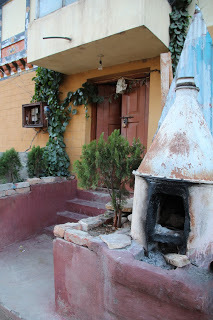 Every building is decorated – Hansel and Gretel windows painted with flowers and swirling linesThe sun is beginging to lower and the air turns to chill and a stiff breeze whips up but this doesn’t deter us from wanting to explore the ‘old town’ of Paro. At first our guide stays close and tries to direct us to various shops, but I am not use to being led around. This is my first time ever on a tour and a first time ever with a guide – both a requirement for your tourist visa to Bhutan. We ask our guide if we are allowed to wander around the town by ourselves. He’s reluctant to let us – this being our first day – and tells us that he should be with us, to help. We assure him we won’t go far and agree to meet him in an hour. Once away I find a charm and delight in discovering Paro. Every building is decorated – Hansel and Gretel windows painted with flowers and swirling lines.
Every building is decorated – Hansel and Gretel windows painted with flowers and swirling linesThe sun is beginging to lower and the air turns to chill and a stiff breeze whips up but this doesn’t deter us from wanting to explore the ‘old town’ of Paro. At first our guide stays close and tries to direct us to various shops, but I am not use to being led around. This is my first time ever on a tour and a first time ever with a guide – both a requirement for your tourist visa to Bhutan. We ask our guide if we are allowed to wander around the town by ourselves. He’s reluctant to let us – this being our first day – and tells us that he should be with us, to help. We assure him we won’t go far and agree to meet him in an hour. Once away I find a charm and delight in discovering Paro. Every building is decorated – Hansel and Gretel windows painted with flowers and swirling lines.  Ribbons of chilli’s hang over the windows like curtains and Buddhist artefacts, smiling penises and gold and wooden prayer wheels peek out of glass panes. Inside the shops are filled with the finest weavings, ornate carvings, softest scarfs and vibrant thangkas – a treasure trove of incredible workmanship. As I watch a woman sit at a handloom, weaving the most intricate piece of fabric, I feel the presence of my guide – it’s time to head back to the resort, he tells us. Dinner is at seven and we are whisked off.
Ribbons of chilli’s hang over the windows like curtains and Buddhist artefacts, smiling penises and gold and wooden prayer wheels peek out of glass panes. Inside the shops are filled with the finest weavings, ornate carvings, softest scarfs and vibrant thangkas – a treasure trove of incredible workmanship. As I watch a woman sit at a handloom, weaving the most intricate piece of fabric, I feel the presence of my guide – it’s time to head back to the resort, he tells us. Dinner is at seven and we are whisked off.
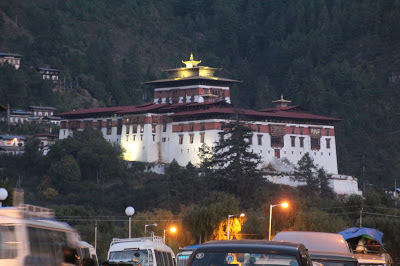
We bid good evening to the driver and guide and go into the resorts restaurant – it’s a buffet meal, enjoyable, but all continental dishes. Just as we’re finishing our main the staff come over to ask if we care for any more as they are about to remove the buffet – there’s a second sitting. We go to move but they say we can stay for our coffee; they are just clearing away the food. The restaurant fills up - Indian Nationals - and then our noses are tantalised, spicy aromas waft past - the new dishes being put out are curries. I watch Mal’s face drop at the realisation he is too full to indulge. We wander back out into the common sitting area, order a Druk Larger. “At least it’s not dry Tuesday” I tease him – a smile splashes across his dial.

Published on November 09, 2015 20:08
September 28, 2015
Buddhas, Bombs and the Babu - Book Trailer
Once upon a time, in a time long, long ago, a little girl had a dream, a dream to sit in a room all by herself. This room would be filled with books, lots and lots of books spilling from the bookcases, stacked on desk, covering the floor and anywhere else there was space. It would have a desk covered with stuff - pens, writing pads, scrunched up balls of paper and cups of cold coffee, and it would have a big overstuffed chair with a side table covered in remanent stains of coffee rings. This girl dreamed of sitting in this room and stare at the wall while her fingers tapped furiously away at a machine, pounding out words, turning words into sentences, sentences into paragraphs and whipping it all into a story. Her whole life, all she wanted to do was sit in the room and write.
Well not quite all.
She also wanted to dance across the contours of borders, wander an open road, to fly across a sky of uncountable stars and then write all about it. That was the dream. To be a writer, to be an Author.
And in a few weeks time the 'Author' dream is about to become a reality. So as I await the realisation of this dream I find there is much more to being a fully fledged author than just tapping out a few words, seeing it bound and maybe ringing up the local radio station for a speal on the book.
I have to build a BUZZ. Cause a vibration. Start a wildfire.
I knew I had to do some marketing work - organise some bookmarks and postcards to send out to book shops, poster here and there, contact a few book groups and libraries to chat too, but as I googled the sites on "marketing your book" I learn there is so much more. Amoung the fountain of ideas was The Book Trailer.
Now up until a month ago, I'd never even heard of a book trailer. Sure I'd heard of trailers for movies and I'd come across countless videos of author chats and 'how too' videos but not book trailers. So a little google wander sent me of a whole new journey, and it turns out, book trailers have been around for years - huge in America - and are now becoming the norm in Australia, most of the big publishers make and send them out to the bookshops as part of the marketing package. I had a chat with a bookshop owner friend of mine and she explained they are a brilliant Author Package Tool as they bring an auditory emotional feel to the book, if the trailer is engaging, just like a movie trailer, it'll entice the shop owner to put the book on the shelves. Turns out my book will be competing with 7000 titles that hit the market every month - anything to give an enticement, that got me interested in definitely making one.
So where to start - I didn't have a clue. I am not a movie maker, hopeless at even taking a video on the camera - a bit of a shaker, with a addition to the zoomer - so I wasn't sure how I was going to come up with something that might be worth even glancing at. I also had to find some software. I might work on a computer all day, but I don't know the first thing about computers or software. Thankfully I have a writer friend who knows a little something about PowerPoint... that was a start, then when she had a look at what 'freebies' her computer had come with - there was MovieMaker. With her generous offer of a day of her time, armed with a couple of photos I landed on her door step first thing in the morning and we began the day musing over the photos picking the 'best' ones - that was hard because I love all my Nepal photos equally... except for the ones of me... then we installed them, lost them, found them, lost them again, argued, took time out for coffee, then discovered they (the photos) had set up their own little file which we had to wrangle them from . Finally the photos fell into a movie strip, and text and fades were added, only to lose the whole bloody thing again. It was wine o'clock time by that stage. Over the following week I scoured the websites for music I could use. Every tune I thought might work was voted down by the new production team I'd suddenly found gathered behind me. But seriously, it was all my fault in the first place for this happening, as I had come home with the put together piece and insisted that M, Bud and the Gorgeous Gal look at it and give me their thoughts. A once over wasn't not enough, I insisted they look at it, over and over, and then some more. So when it came to choosing the music, they felt they now had an invested right. I eventually came across a fabulous website called 300Monks (royalty free music) and after much shuffling through endless wonderful tunes, finally found the perfect beat we all agreed upon. "Chakra Superstar" from the A Magnificent beautiful day by The Winston Giles Orchestra (a Melbourne band), is just so quirky and upbeat, and for me evoked the mystery and joy we had found in Nepal and its people on our first visit there. As I uploaded the trailer to Youtube and Vimeo, I suddenly discovered I was now a 'channel owner' good grief! I have my own 'entertainment station' WOW, next step, Ted Turner land... (you can tell I'm a bit of a social media luddite!) I notice now my book trailer is looking a little lonely on Channel Kerry Tolson. Might have to BUZZ it up! Once again I hit the google train and find the catch phase "VLOGing" . A new 'frontier' for me to discover. This brings to mind a line from one of my favourite Book Trailers, How I Almost Lost My Mind Trying to Understand My Brain by Dennis Cass. Quote: "That's the dream, twenty years when I wanted to become a writer, a big part of the dream was being able to put little videos on the internet. That's why we do this. Maybe I'll just stop writing and I'll just do downloads, apps and widgets..."
https://www.youtube.com/watch?v=yxschLOAr-s
Published on September 28, 2015 01:37
September 21, 2015
Have a peek around the 'backyard'
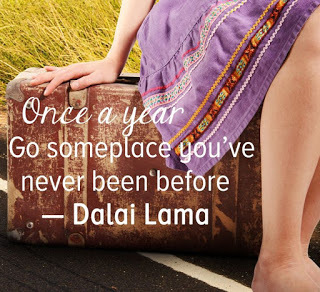 from Savvysugar.comThere's a little (mis)quote attributed to the Dalai Lama that I just love and try to live by "Once a year As often as possible, go someplace you’ve never been before." and every year I plan a new destination, but while I dream and plan the next big trip, I try to keep the wanderlust at bay by living a similar quote by Katja Hentschel (Travelettes www.travelettes.net) with her "Once a month, go somewhere you've never been before."....and try and find places close to my backdoor to go visit.
from Savvysugar.comThere's a little (mis)quote attributed to the Dalai Lama that I just love and try to live by "Once a year As often as possible, go someplace you’ve never been before." and every year I plan a new destination, but while I dream and plan the next big trip, I try to keep the wanderlust at bay by living a similar quote by Katja Hentschel (Travelettes www.travelettes.net) with her "Once a month, go somewhere you've never been before."....and try and find places close to my backdoor to go visit. Last Sunday morning, after our weekend 'chores' of early morning stroll around the village, check on the platypus in the creek and pick up our regular Sunday coffee from our local barista, we sat on our backdeck, and wondered where to go that was close and 'new'. A flick through the local North Coast markets website threw up the name 'Pottsville'. We had driven through Pottsville and it's twin village, Hastings Point countless times, but had never stopped - ever - not once in twenty-five years of living on the north coast. So off we trundle with the treadlies, to the tiny little seaside village of Pottsville.
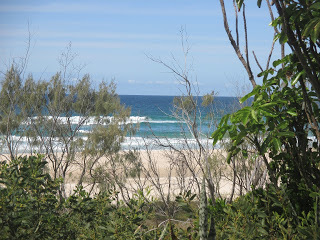 I had always thought of Pottsville as a very much blink and you'll miss it sleepy little hamlet with a peep-of-a-beach hidden from the road behind a large sand-dune. Many a time we've just driven straight through it; winding our way off the main highway and following the coastal road from Brunswick to Tweed, thinking is was just a group of houses facing the ocean. But how wrong we were...
I had always thought of Pottsville as a very much blink and you'll miss it sleepy little hamlet with a peep-of-a-beach hidden from the road behind a large sand-dune. Many a time we've just driven straight through it; winding our way off the main highway and following the coastal road from Brunswick to Tweed, thinking is was just a group of houses facing the ocean. But how wrong we were... Parking the car at the brand new estate of Black Rocks -which is just off the main road, across the sandy inlet and behind a reserve- we unloaded the treadlies and pedalled our way along a flat wide bike path with creek and wetlands on one side and expanse lawns and quite streets on the other. It didn't take too long to wind our way to the market site where the Pottsville Community Markets were in full swing - featuring lots of the usual creative stalls that can be found around the north-coast markets, but also delightfully interesting art stalls, musicians and a fabulous entertaining children's show. Even more surprising for M and I as we biked through the market was to 'bump into' our darling granddaughter who was having a lovely little dance on the green - it turned out Bud and Gorgeous Gal (along with the grandbubbas) had had a similar idea that morning of taking a Sunday drive and turning it into a little day adventure of their own - markets and beach in the morning with mountains and boulders thrown in for the afternoon (Pottsville to Nimbin).
Parking the car at the brand new estate of Black Rocks -which is just off the main road, across the sandy inlet and behind a reserve- we unloaded the treadlies and pedalled our way along a flat wide bike path with creek and wetlands on one side and expanse lawns and quite streets on the other. It didn't take too long to wind our way to the market site where the Pottsville Community Markets were in full swing - featuring lots of the usual creative stalls that can be found around the north-coast markets, but also delightfully interesting art stalls, musicians and a fabulous entertaining children's show. Even more surprising for M and I as we biked through the market was to 'bump into' our darling granddaughter who was having a lovely little dance on the green - it turned out Bud and Gorgeous Gal (along with the grandbubbas) had had a similar idea that morning of taking a Sunday drive and turning it into a little day adventure of their own - markets and beach in the morning with mountains and boulders thrown in for the afternoon (Pottsville to Nimbin).
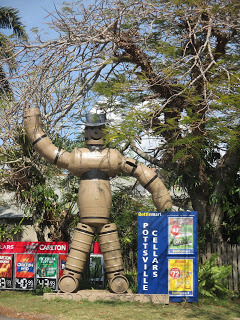 Turning into the high street of the town we hit the hub - which, although quaint, was also very new. No colonial or vintage charm here, for Pottsville is a relatively 'new' town - the first house being built there in 1930 by a chap called Bill Potts. Despite this, its still a bustling little place full of coffee shops with a touch of quirk.
Turning into the high street of the town we hit the hub - which, although quaint, was also very new. No colonial or vintage charm here, for Pottsville is a relatively 'new' town - the first house being built there in 1930 by a chap called Bill Potts. Despite this, its still a bustling little place full of coffee shops with a touch of quirk. It doesn't take long to ride through the town and before we know it we're back in suburbia where all the homes have a same-same appearance of costal-lux with wide treed boulevards and lush gardens filled with abundant birdlife. Just as I was thinking that it was becoming a little ho-hum, we suddenly happen upon a expanse of bushland which is ringing with bellbird tings and a whip or two echoing through the greenery.
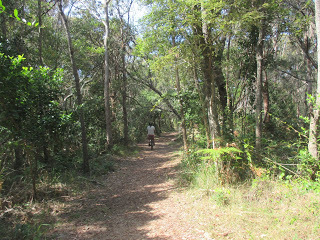 Entering into a high gated area the bike path morphs into a bark chipped track and sunlight filters through gum and melaleucas as we ride deeper into the Pottsville Environmental Park - home to less than 150koalas and the endangered Bush Thick Knee. When I first read the sign declaring the park to be home of Thick Knees I become all excited thinking it must be some kind of rare breed of Koala (seriously!)... one with really fat knees and wondering how in the world you could 'see' a Koala's knees in the first place... of course it's nothing of the sort!
Entering into a high gated area the bike path morphs into a bark chipped track and sunlight filters through gum and melaleucas as we ride deeper into the Pottsville Environmental Park - home to less than 150koalas and the endangered Bush Thick Knee. When I first read the sign declaring the park to be home of Thick Knees I become all excited thinking it must be some kind of rare breed of Koala (seriously!)... one with really fat knees and wondering how in the world you could 'see' a Koala's knees in the first place... of course it's nothing of the sort! The Bush Thick Knee turns out to be a bird - a curlew. Ah yes, curlews have very knobbly knees indeed - bit rude to call them thick though.
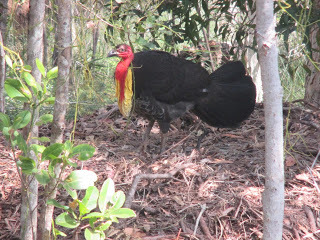 The park is a delight, perfect for cycling and walking through with at least five tracks to choose from; all leading to various areas of the park and following the line of Cudgera Creek and wetlands. The bird and animal life is abundant and we need to be vigilant that we don't run over/into curlews and turkeys that have scattered themselves along the various tracks, and we are constantly stopping to take in the masses of birds flittering and swooping around the trees, along with clouds of butterflies and bees.
The park is a delight, perfect for cycling and walking through with at least five tracks to choose from; all leading to various areas of the park and following the line of Cudgera Creek and wetlands. The bird and animal life is abundant and we need to be vigilant that we don't run over/into curlews and turkeys that have scattered themselves along the various tracks, and we are constantly stopping to take in the masses of birds flittering and swooping around the trees, along with clouds of butterflies and bees. 
 I'm having such a wonderful time becoming lost in the fern glades that as I come around the corner I almost have a head-on with an enormous goanna who is ambling up the middle of the track. He's HUGH!....with massive claws and mouth, which flicks out an incredibly enormous tongue. I hit the brakes just in time and am narrowly missed being belted from behind by M who is also riding merrily along with his head also lost in the beauty of the ferns. The goanna runs first at me then turns quickly and is up a tree before I am even off the bike and running away in the opposite direction.It takes us almost two hours to ride all five tracks of the park, then we make our way towards the beautiful beach of Pottsville - stunning is a word that is just not going to cut it when describing this beach.
I'm having such a wonderful time becoming lost in the fern glades that as I come around the corner I almost have a head-on with an enormous goanna who is ambling up the middle of the track. He's HUGH!....with massive claws and mouth, which flicks out an incredibly enormous tongue. I hit the brakes just in time and am narrowly missed being belted from behind by M who is also riding merrily along with his head also lost in the beauty of the ferns. The goanna runs first at me then turns quickly and is up a tree before I am even off the bike and running away in the opposite direction.It takes us almost two hours to ride all five tracks of the park, then we make our way towards the beautiful beach of Pottsville - stunning is a word that is just not going to cut it when describing this beach. 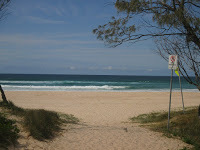 It would have to be one of the most beautiful beaches I've ever see in Australia. Long, golden, glorious... although I must say, the signs to all the entries of the beach had me a little nervous - they were full of warnings about Sharks.
It would have to be one of the most beautiful beaches I've ever see in Australia. Long, golden, glorious... although I must say, the signs to all the entries of the beach had me a little nervous - they were full of warnings about Sharks. 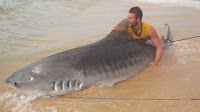 http://www.abc.net.au/local/photos/2015/04/09/4213167.htm2015 has been quite a year for the North Coast and shark incidents, so it really doesn't surprised me too much to see the shark warning signs, however these signs appear to be old, some are faded and it had me wondering how common it was for shark sightings here - a search of news items shows that it's fairly common, including an amazing article in the April of this year showing a massive tigershark being reeled in from the beach - it took 3hours! (what stunned me more was the chap does it in the name of conservation and tracks the sharks through a catch and release.) As much as I like the water, M and I decided to give the surf a miss and instead just enjoy the feeling the golden sands scrunching under our feet.
http://www.abc.net.au/local/photos/2015/04/09/4213167.htm2015 has been quite a year for the North Coast and shark incidents, so it really doesn't surprised me too much to see the shark warning signs, however these signs appear to be old, some are faded and it had me wondering how common it was for shark sightings here - a search of news items shows that it's fairly common, including an amazing article in the April of this year showing a massive tigershark being reeled in from the beach - it took 3hours! (what stunned me more was the chap does it in the name of conservation and tracks the sharks through a catch and release.) As much as I like the water, M and I decided to give the surf a miss and instead just enjoy the feeling the golden sands scrunching under our feet.
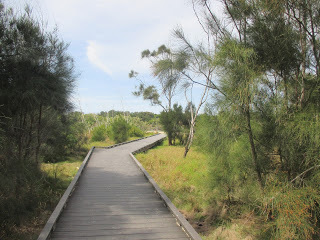 Further back down towards the main part of the village the bike path leads to expansive boardwalks that take you to the Mooball Creek Inlet, again, another beautiful picturesque waterway this time filled with families wading in the shallows and sand castles being built. In the background, coming from the park, we hear the rhythmic tribal beats sounds of djembes and flutes, and laughing children enjoying the sunshine.Back at the markets, we took a quick once round, then headed off for a scrumptious (late)lunch at one of the many eateries lining the main hub. The plan was to indulge in coffee then take a ride up to the next hamlet - Hastings Point - another village we've always driven straight through, with nary a glance either side. Just as we were finishing what I would have to say was one of the best burgers I've had in a very long time, we noticed the birds were bundling about in blustering flocks, screeching and shrilling, the air had become icy and as the wind swirled up, blackness fell across the sky and clouds rolled in - we decided to skip our afternoon plans and hightailed it back along the bike track - lightning flicked across the sky and rumbles vibrated the air. Swallows and finches darted crazily about, anticipating a pounding from the heavens. Packing the bikes into the car, the air tasted damp and as we drove towards the highway, the storm passed over, with nary a drop.
Further back down towards the main part of the village the bike path leads to expansive boardwalks that take you to the Mooball Creek Inlet, again, another beautiful picturesque waterway this time filled with families wading in the shallows and sand castles being built. In the background, coming from the park, we hear the rhythmic tribal beats sounds of djembes and flutes, and laughing children enjoying the sunshine.Back at the markets, we took a quick once round, then headed off for a scrumptious (late)lunch at one of the many eateries lining the main hub. The plan was to indulge in coffee then take a ride up to the next hamlet - Hastings Point - another village we've always driven straight through, with nary a glance either side. Just as we were finishing what I would have to say was one of the best burgers I've had in a very long time, we noticed the birds were bundling about in blustering flocks, screeching and shrilling, the air had become icy and as the wind swirled up, blackness fell across the sky and clouds rolled in - we decided to skip our afternoon plans and hightailed it back along the bike track - lightning flicked across the sky and rumbles vibrated the air. Swallows and finches darted crazily about, anticipating a pounding from the heavens. Packing the bikes into the car, the air tasted damp and as we drove towards the highway, the storm passed over, with nary a drop. I make a mental note to pop Hastings Point on the 'next month new spot' list and add Pottsville to the 'will return one day' list.
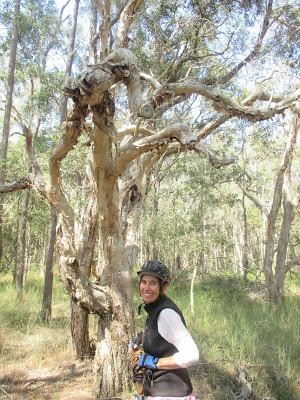
happy travels....
Published on September 21, 2015 06:44

